From childhood sleepovers to charming guest rooms, twin bedrooms offer nostalgic appeal and versatile functionality. Designers and homeowners alike champion twin beds for their ability to optimize tight quarters, create harmonious symmetry, and adapt to varied hosting needs. Whether nestled under eaves in an attic or styled as daybeds in modern minimalist layouts, twin beds transform limited footprints into inviting retreats. This article explores 20 inspired twin bedroom ideas—from creative storage solutions and striking accent walls to clever lighting techniques and personalized décor—that blend style with practicality to elevate your space. Dive in and discover how to craft a memorable twin bedroom that balances design flair with everyday comfort.
1. Add Hidden Storage
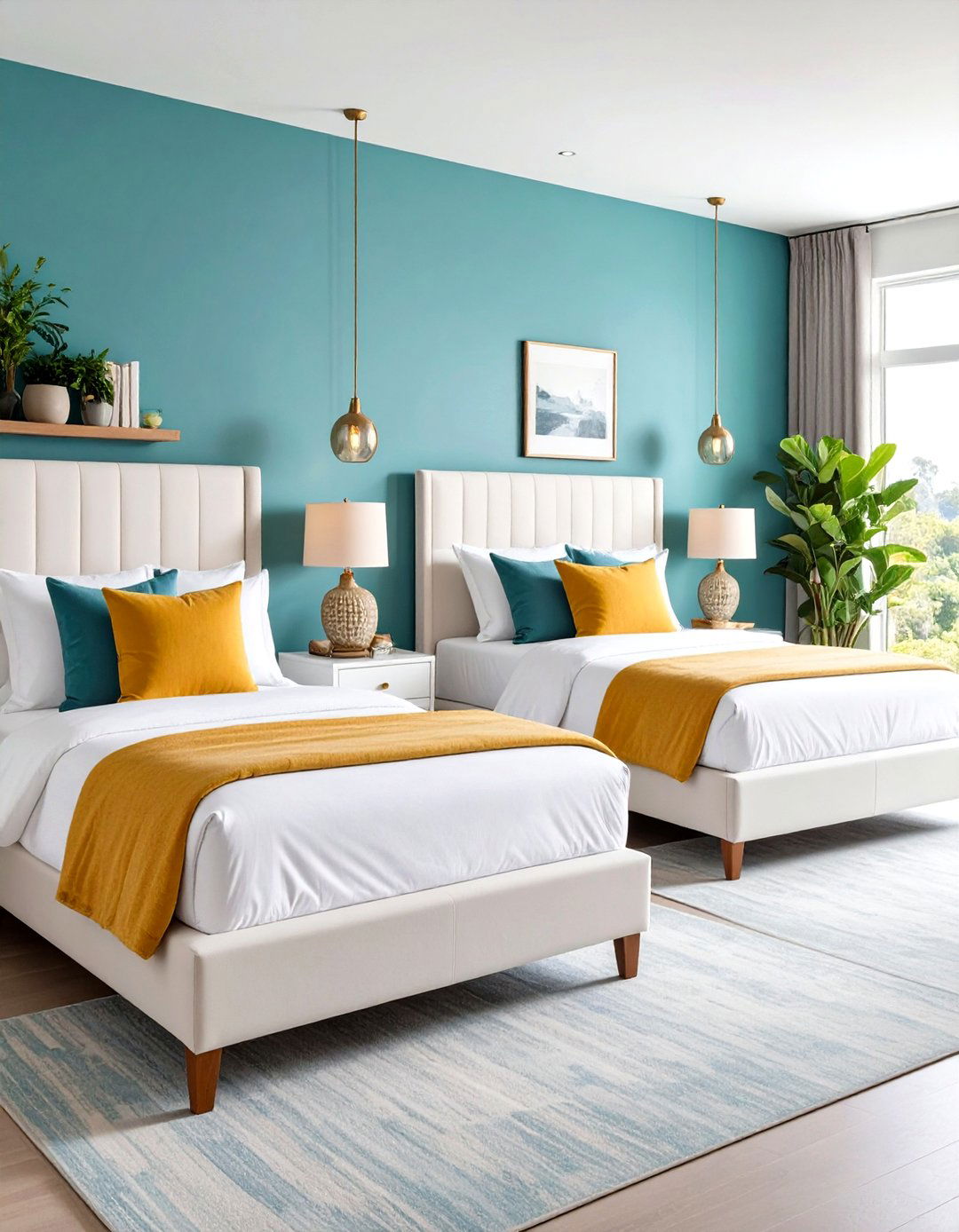
One of the most effective ways to maintain a clean and organized twin bedroom is to incorporate hidden storage. A wide dresser or nightstand placed between two twin beds can serve dual purposes—providing a surface for bedside essentials and concealing clutter within hidden compartments. Interior designer Ghislaine Viñas demonstrates this approach by selecting a shared nightstand outfitted with deep drawers that cater to each sleeper’s belongings, ensuring personal items remain tucked away yet easily accessible. By combining concealed storage with decorative elements like mismatched lamps or textured finishes, you create a functional and visually appealing focal point that maximizes space.
2. Wall-Mount the Headboard
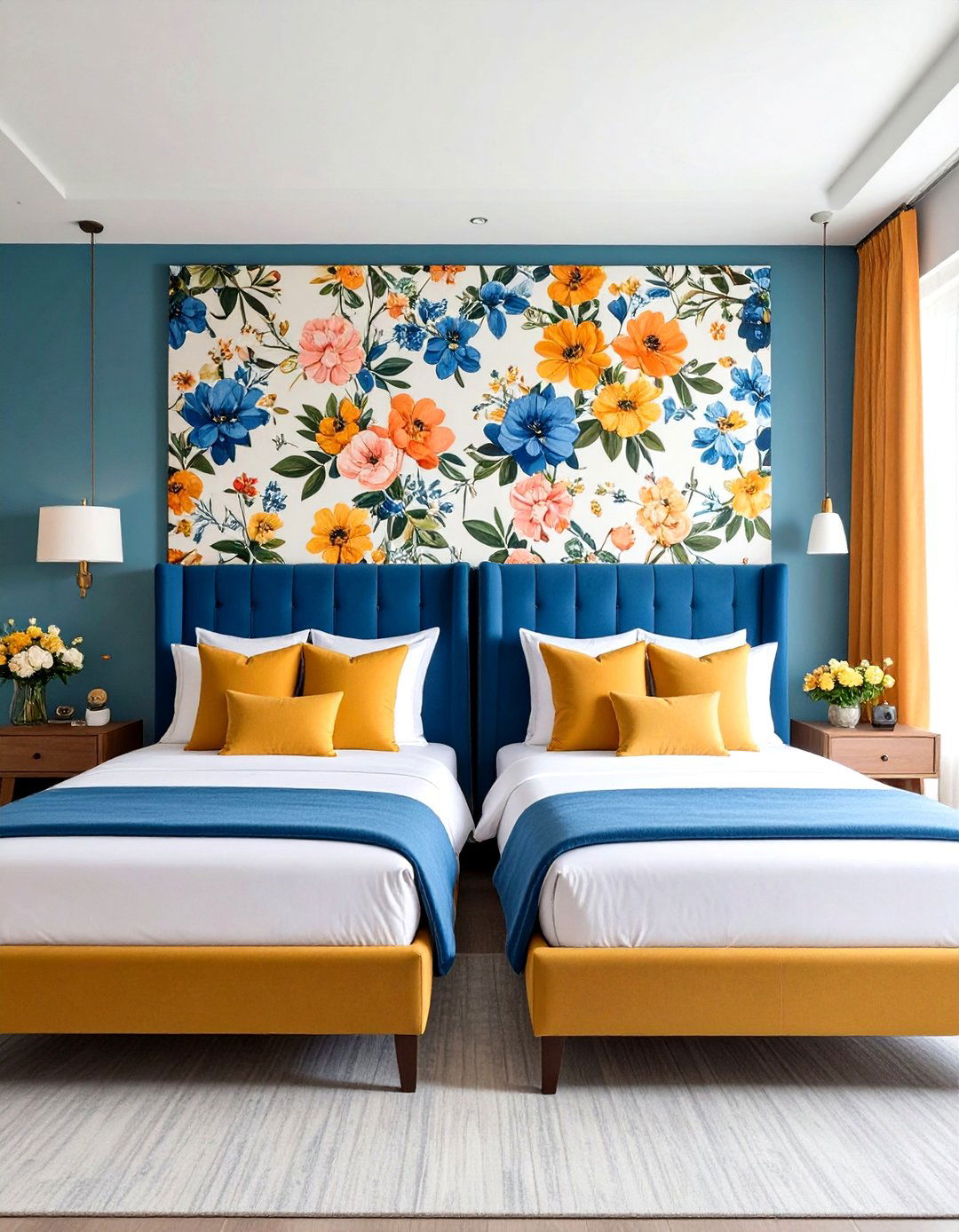
Wall-mounting a headboard offers both aesthetic polish and valuable floor space in a twin bedroom. By affixing a continuous, single headboard directly to the wall, you eliminate the need for bulky bed frames, instantly creating a sleeker, more streamlined look. This technique works especially well in compact rooms where clearance is limited yet visual impact is desired. Interior designer Jessica Davis of Atelier Davis paired a blue-and-white floral upholstered headboard with warm coral and mustard accents to infuse color and character into a shared bedroom, demonstrating how a unified headboard can tie disparate décor elements together and lend an air of cohesion.
3. Try a Kitty-Corner Layout
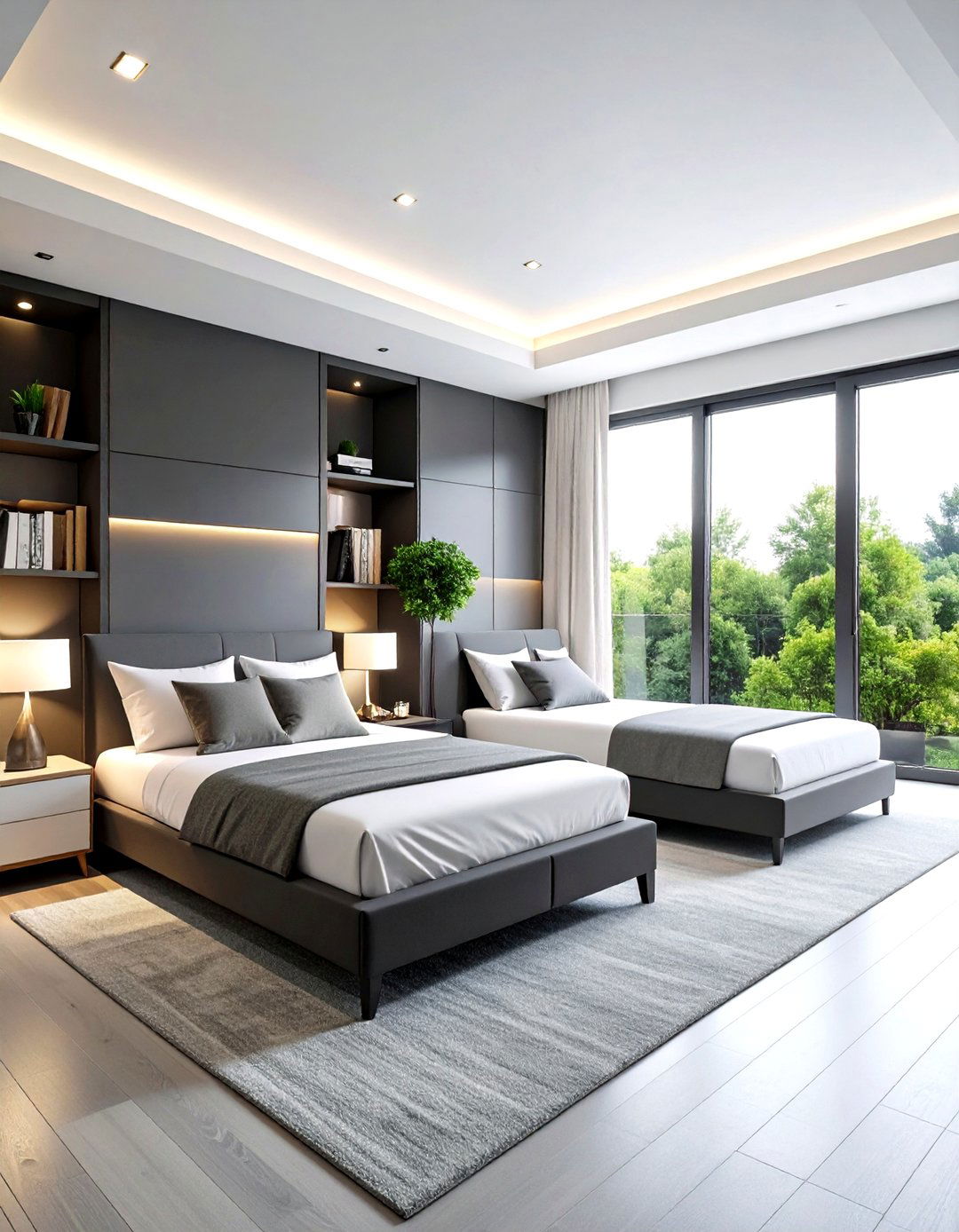
Positioning twin beds in a kitty-corner configuration can dramatically enhance the perceived roominess of a small bedroom. By angling each bed diagonally across from one another, you break up linear lines and open up floor pathways, creating an inviting sense of flow. In this minimalist guest room designed by Fantastic Frank, the black-and-white color palette underscores the geometric arrangement, while an integrated reading nook in the corner maximizes functionality without overcrowding the space. Whether you’re working with a square or rectangular footprint, adopting a kitty-corner layout introduces a playful yet practical alternative to conventional side-by-side bed placements.
4. Opt for a Shared Lamp

Instead of cluttering a small nightstand with two separate lamps, consider a single, oversized table lamp to illuminate both twin beds simultaneously. A substantial lamp not only reduces visual clutter but also serves as a bold design statement, drawing the eye upward and enhancing vertical interest. BHDM Design exemplifies this strategy by placing a tall lamp on a narrow shared bedside cabinet in a neutral-toned bedroom, where the lamp’s scale accentuates the room’s height and provides balanced illumination for late-night reading. Selecting a lamp with a distinctive silhouette or a textured base can further personalize the space and harmonize the overall décor.
5. Push the Beds Together
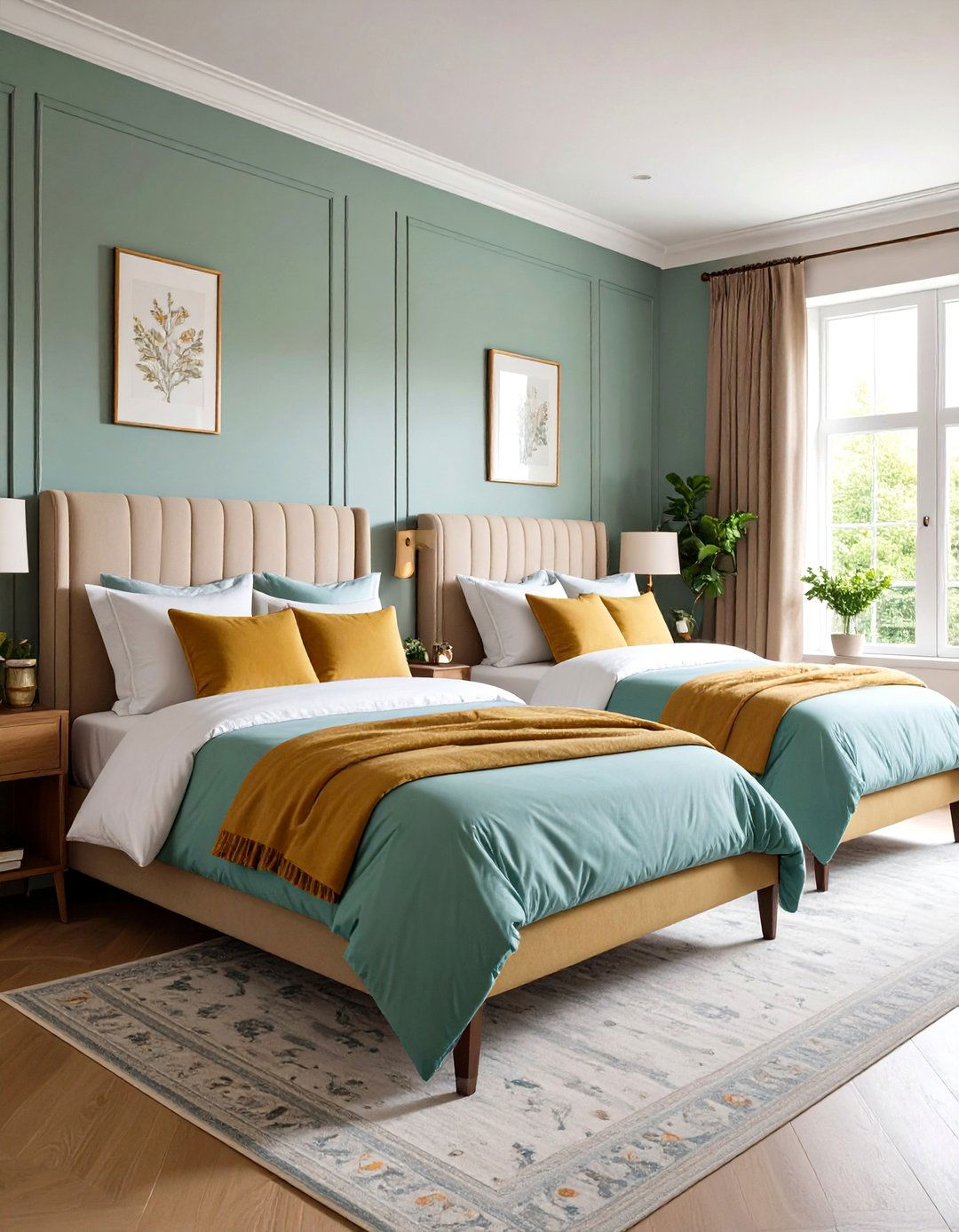
Pushing twin beds together can instantly evoke the luxury of a boutique hotel while maximizing usable floor space. When aligned side by side, the beds take on the appearance of a larger sleeping surface, which can be dressed with a shared duvet or coordinated bedding sets for a cohesive look. In a London residence designed by Studio Peake, the beds were nestled against a recessed niche where a bedside table and lamp fit perfectly, creating a cozy alcove feel. This arrangement not only lends a sense of intimacy but also offers flexible sleeping options, allowing the configuration to function as either separate beds or a unified whole.
6. Hang a Pair of Sconces
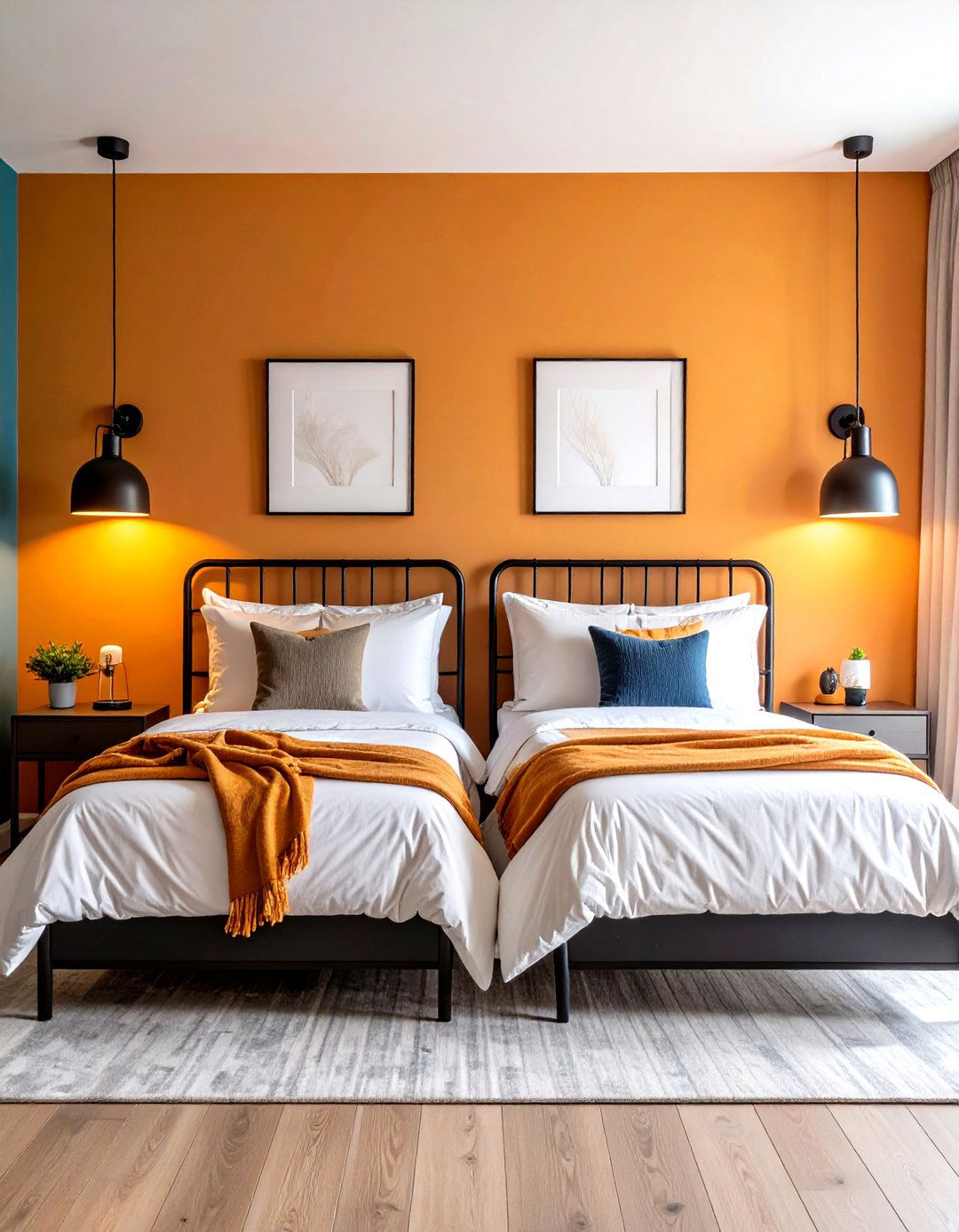
Wall-mounted sconces are a smart alternative to bedside lamps, freeing up nightstand surfaces and creating a streamlined silhouette. By installing a pair of sconces directly above each twin bed, you ensure focused illumination for reading without sacrificing shelf space. Studio Robert McKinley embraced an industrial-chic aesthetic by suspending black metal sconces over vintage-style bed frames, adding textural contrast and framing the sleeping areas. Dimmable fixtures offer adjustable brightness, while the wall-mounted design keeps cords concealed, maintaining clean lines. This approach not only optimizes functionality but also adds an architectural element that elevates the room’s character and highlights individual sleeping zones.
7. Add Storage Ottomans
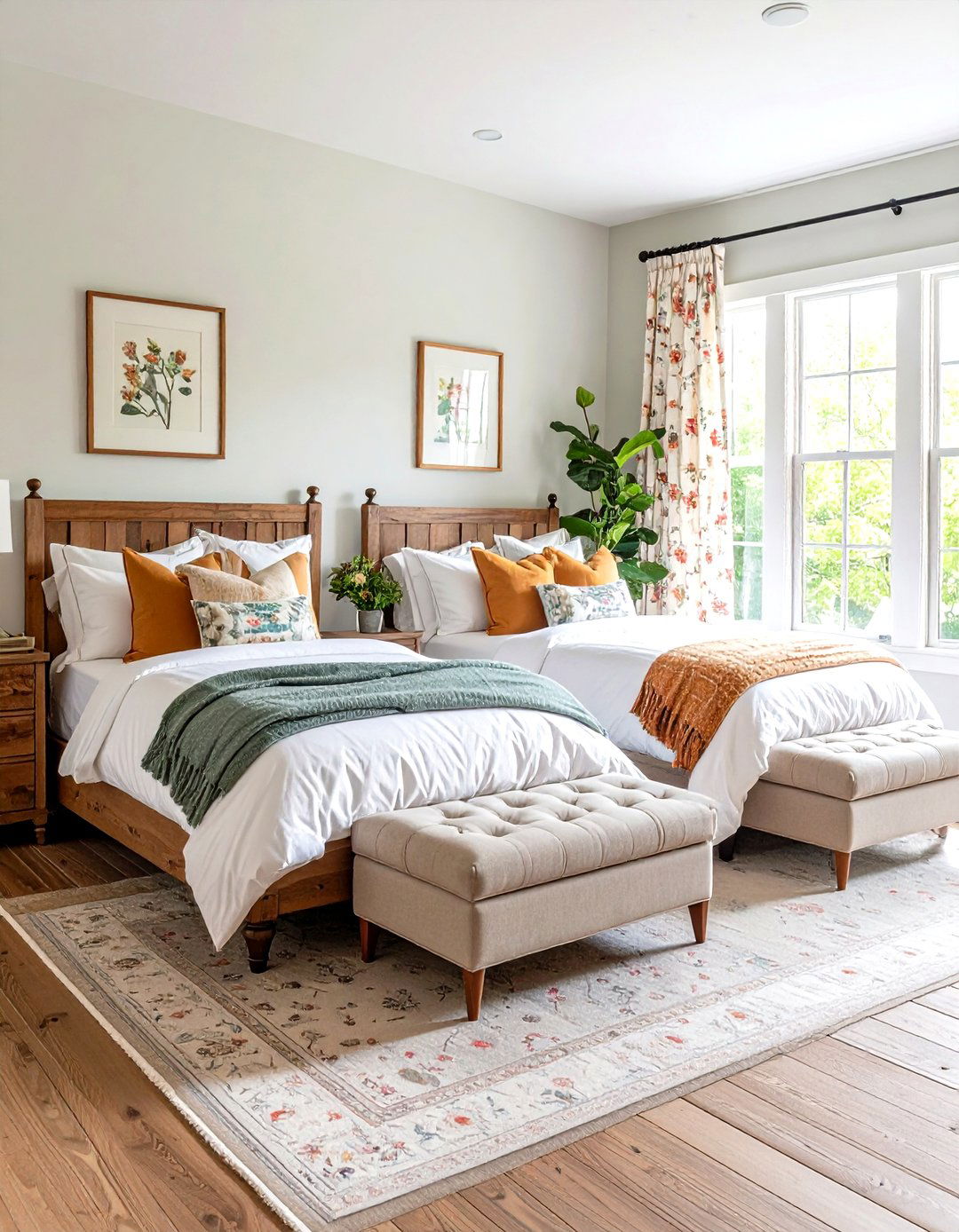
Upholstered storage ottomans at the foot of each twin bed provide concealed space for extra linens, books, or personal items. Their dual functionality offers seating or footrests during the day, while hiding clutter out of sight. In a New York farmhouse-inspired twin bedroom by designer Kara Mann, antique bed frames and crisp white bedding were complemented by floral curtains and sleek ottomans, creating a cozy yet organized aesthetic. Opt for ottomans with lift-up lids or hidden drawers to maximize storage capacity, and choose upholstery fabrics that coordinate with your color scheme. By blending practical storage with comfortable seating, these ottomans enhance both form and function.
8. Tuck Beds Under the Eaves

When working with sloped ceilings or attic spaces, positioning twin beds beneath the eaves capitalizes on low-clearance areas. By aligning beds under the roofline, you open up central floor space for circulation or additional furniture. Britt Design Studio illustrates this tactic with a couple of striped upholstered headboards flanking a central window, where a shared nightstand offers both open shelving and concealed drawers. This layout highlights architectural quirks while ensuring headspace remains unobstructed in the room’s highest sections. Incorporate low-profile bed frames and wall-mounted lighting to further economize on vertical space and maintain an airy, uncluttered atmosphere.
9. Structure With a Half Wall
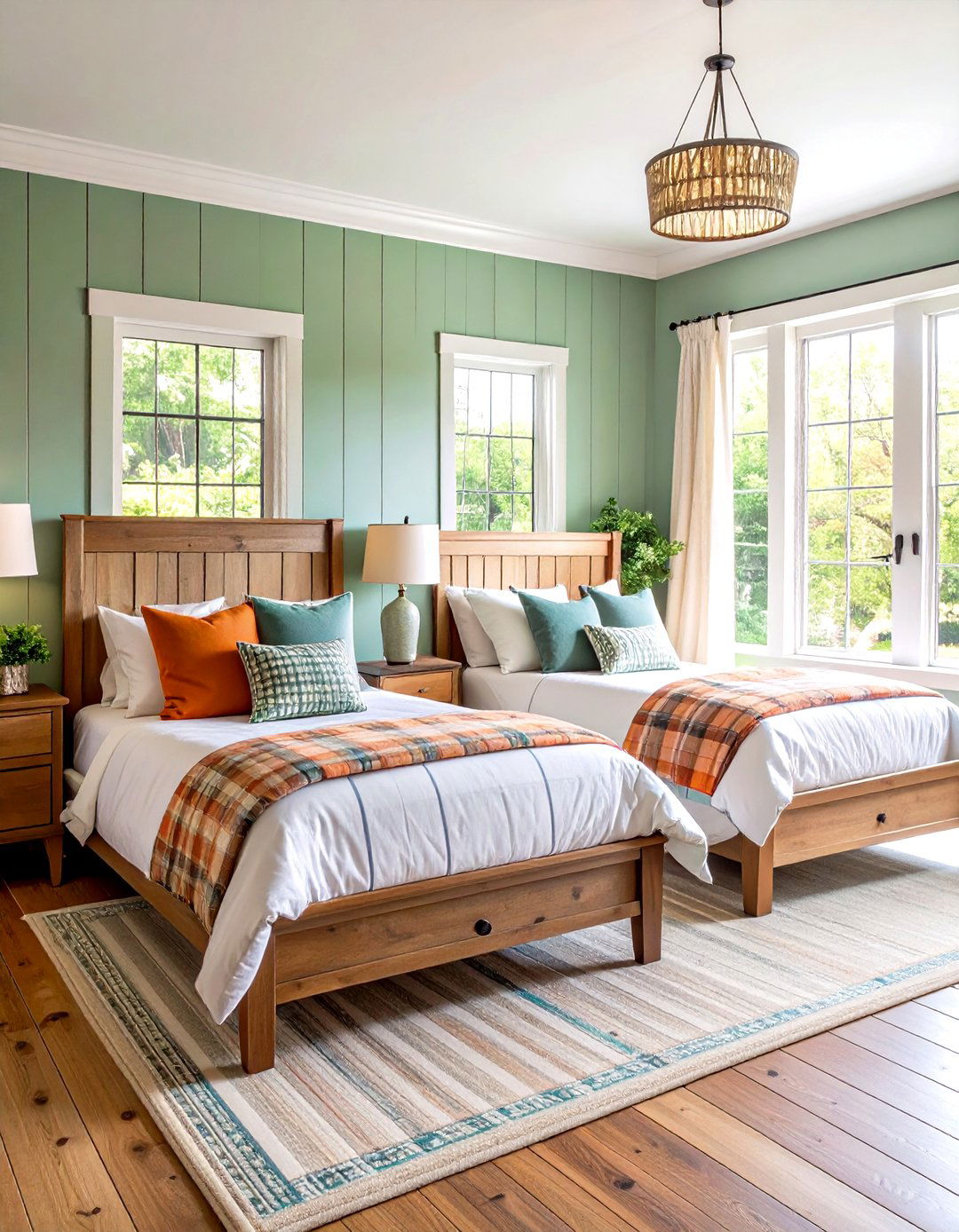
Installing a decorative half wall behind twin beds anchors the sleeping area and adds architectural interest. This partial divider can be finished with paint, wallpaper, or paneling—beadboard, shiplap, or board-and-batten—to introduce texture and color contrast. Jean Liu Design utilizes a neutral plaid accent on a half wall, creating a cozy backdrop for matching twin beds. Beyond aesthetics, the half wall delineates the sleeping zone without fully enclosing the room, preserving openness and light flow. Whether you’re aiming for a cottage vibe with white beadboard or a modern edge with geometric wallpaper, a half wall offers a budget-friendly way to infuse personality into a shared bedroom.
10. Unify With an Area Rug
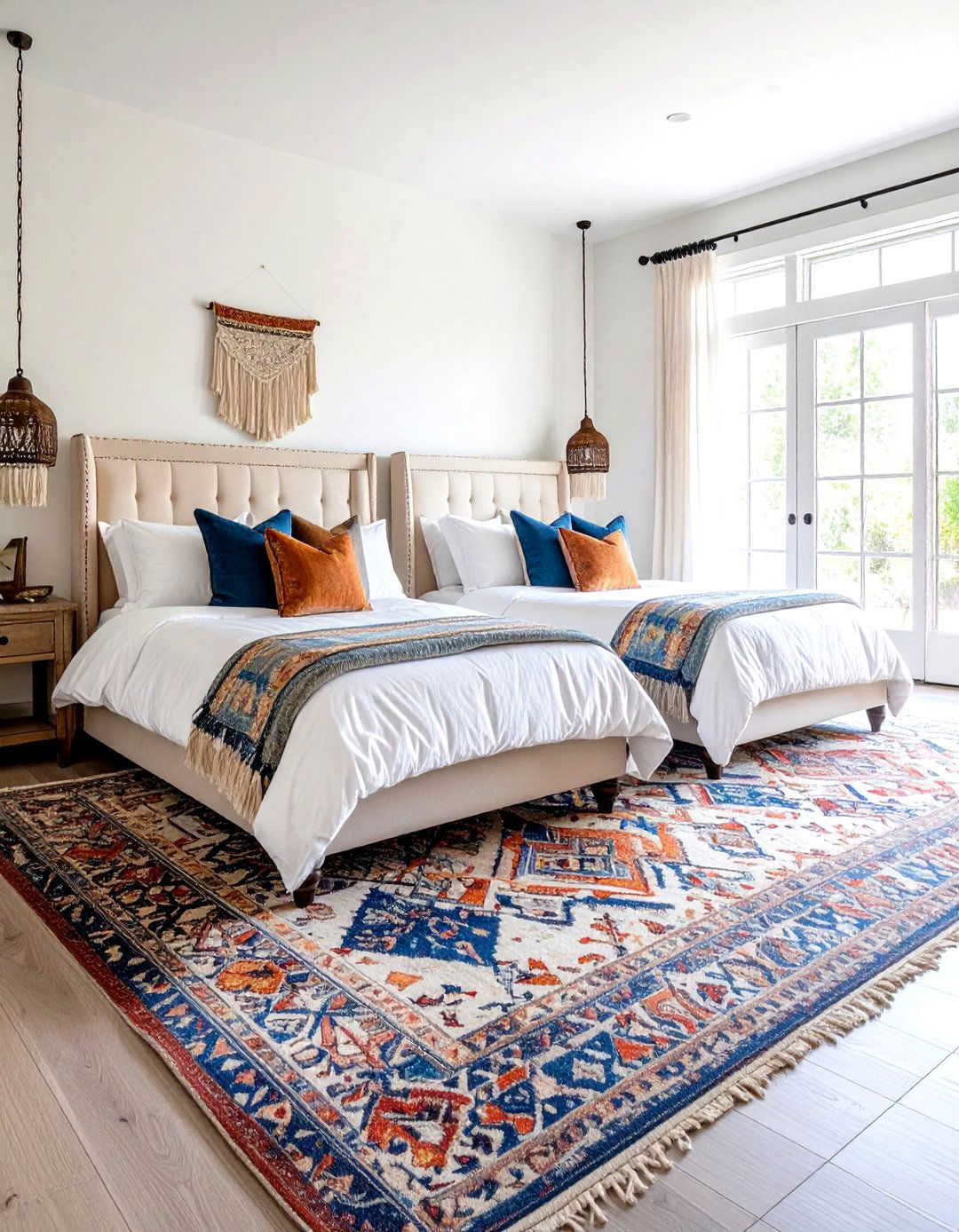
A generous area rug placed beneath twin beds can visually unite two separate sleeping areas into one cohesive design. By floating matching bed frames on a large rug, you define the sleeping zone, add warmth underfoot, and introduce texture or pattern. Erin Williamson Design incorporated a vibrant Moroccan-style rug in a Texas lake house, setting crisp white linens and matching headboards against colorful geometric motifs for a balanced, layered look. Select a rug that complements your color palette and is sized to extend beyond both beds, ensuring the edges frame the room symmetrically and prevent the space from feeling disjointed.
11. Install Wall Canopies

Wall-mounted canopies lend an air of drama and elegance to a twin bedroom while drawing the eye upward, making ceilings feel taller. A pair of fabric canopies installed above each bed creates a regal backdrop and frames high windows or wall art. Matthew Carter Interiors employed ceiling-to-wall printed upholstery to craft canopies that both crown the beds and soften the room’s angles. Choose lightweight fabrics in prints or solids that resonate with your décor theme, and ensure the canopy hardware is securely anchored. This vertical accent adds visual height and a luxurious, custom-finish quality to even the most compact shared spaces.
12. Use an Extra-Wide Table
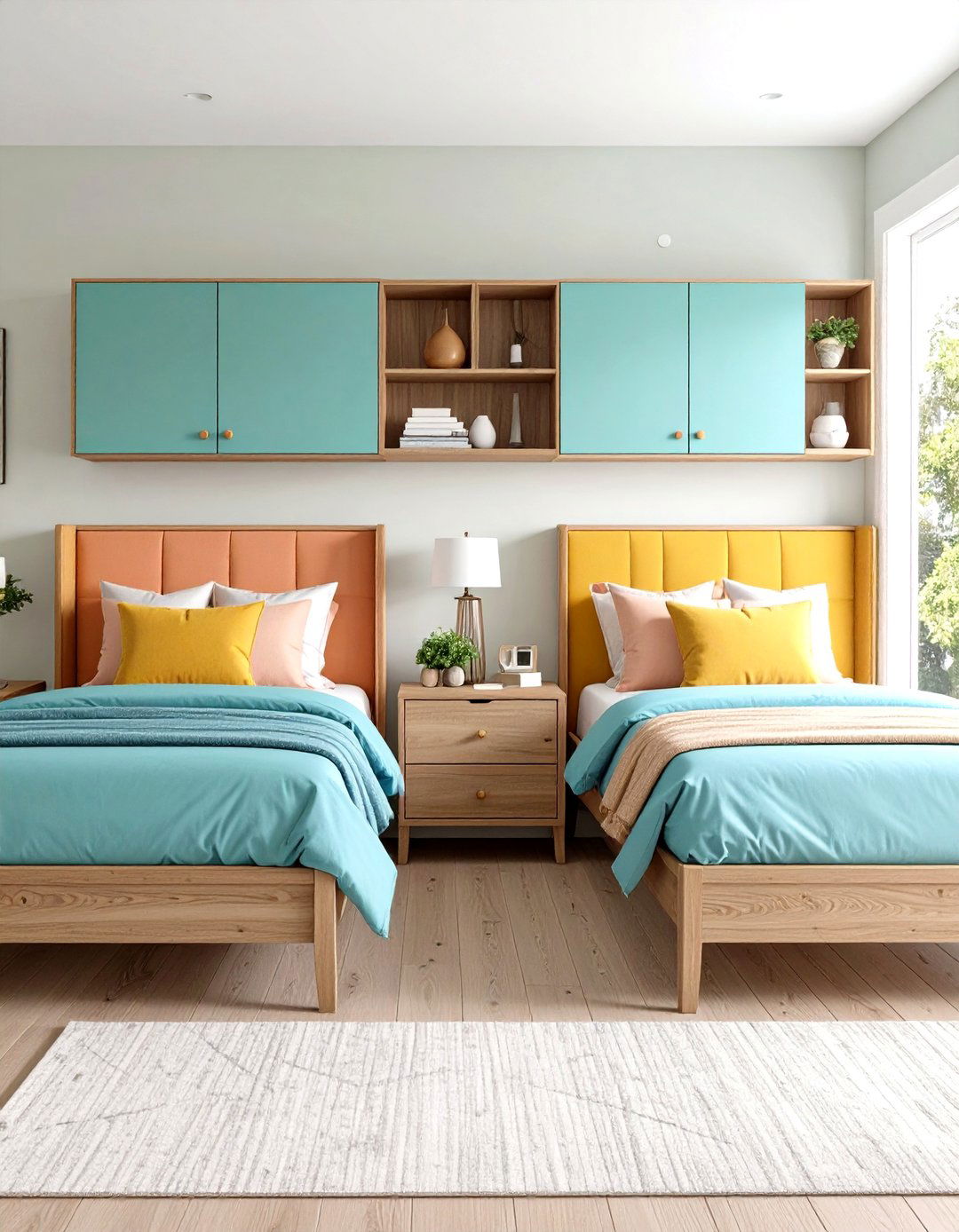
An extra-wide console table or desk positioned between twin beds can serve as a functional and decorative centerpiece. By matching the table’s width to the window or wall segment, you create a balanced look that maximizes storage and display opportunities. Ursula Carmona of Home Made By Carmona utilizes a wooden console that spans the gap between two upholstered headboards, offering open shelving for books and closed drawers for personal items. This configuration maintains symmetry, provides a continuous sightline across the room, and transforms the space into a cohesive vignette. Complement the table with coordinated lamps or greenery to enliven the area.
13. Paint Horizontal Stripes

Horizontal stripes painted across a bedroom wall can optically widen a narrow twin room and inject visual interest. By extending stripes from floor to ceiling, you not only disguise doorways or trim but also emphasize the room’s breadth. Interior designer Ghislaine Viñas applied bold, multicolored horizontal bands on an accent wall, cleverly concealing the door and adding playful energy to the space. To execute this look, measure and tape equal stripe widths, choose contrasting yet harmonious hues, and use high-quality paint for crisp lines. Whether subtle neutrals or vibrant tones, horizontal stripes are an easy DIY technique to broaden and enliven a shared bedroom.
14. Embrace Symmetry
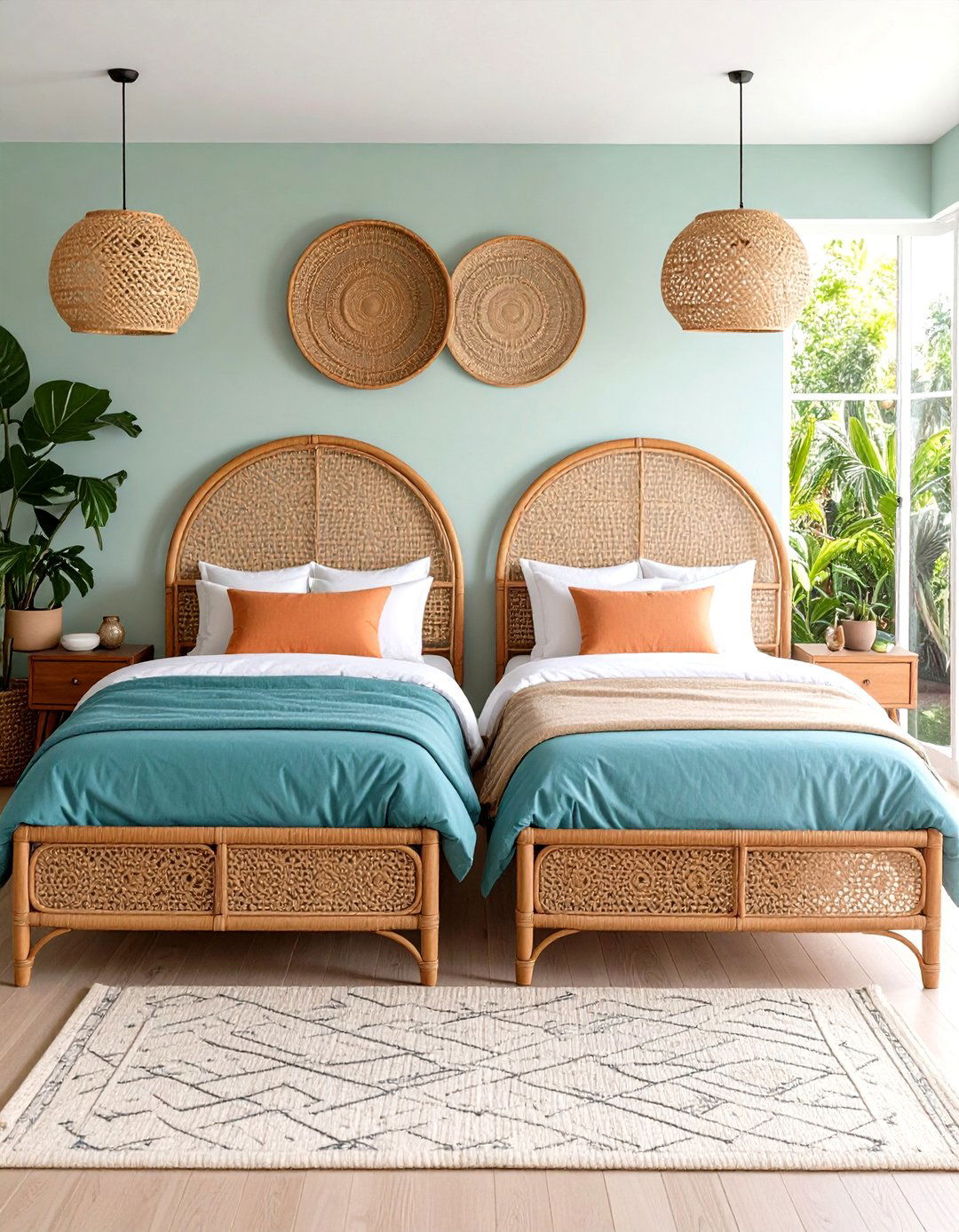
Embracing symmetry in a twin bedroom establishes a harmonious and restful environment. Position identical furniture—such as vintage rattan bed frames—on either side of a central bedside table to create balance and visual calm. Cathie Hong Interiors demonstrates this principle by pairing low-profile midcentury furnishings that emphasize ceiling height without overwhelming the room. Symmetrical arrangements simplify décor choices, allowing you to coordinate bedding, lighting, and accessories for a cohesive impact. Whether you’re aiming for traditional elegance or midcentury modern charm, a symmetrical layout ensures each side mirrors the other, fostering unity and a sense of order in the shared space.
15. Make One a Daybed

Converting one twin bed into a daybed during the day enhances versatility and seating options in a shared bedroom. Position the mattress flush against a wall, accessorize with an assortment of throw pillows, and add a bolster for lumbar support. Paris-based designer Vanessa Scoffier installed this configuration at Hotel Henriette, where the daybed seamlessly transitions into guest accommodation at night. Incorporate a small side table or floating shelf nearby to hold drinks and books, and layer a lightweight throw that doubles as bedding. This approach maximizes multifunctionality, providing a lounging area by day and comfortable sleeping quarters by night.
16. Use Creative Lighting
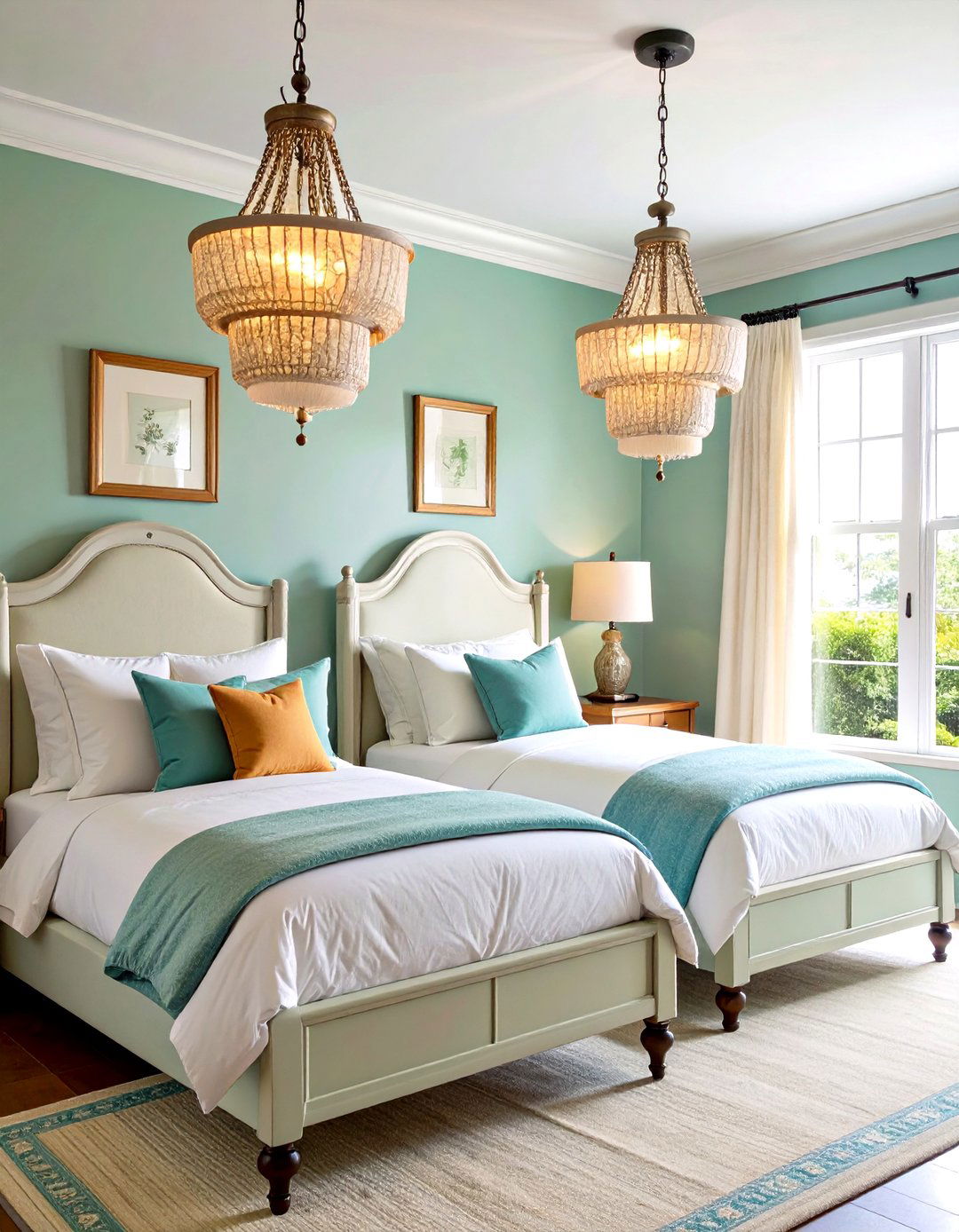
Creative lighting can dramatically transform a twin bedroom’s ambiance, particularly in rooms with lofty ceilings. Instead of traditional bedside lamps, hang pendant lights above each bed or a central fixture that serves both. Leanne Ford Interiors installed a tiered Capiz shell pendant centered above antique twin frames in a whitewashed room, creating a luminous focal point that adds texture and softness. Choose pendants with adjustable cords to fine-tune height, and opt for diffused shades to cast gentle, ambient light. This strategy frees up nightstand space while highlighting architectural details, fostering an open, airy feel perfect for both relaxation and reading.
17. Use Paint to Divide Space
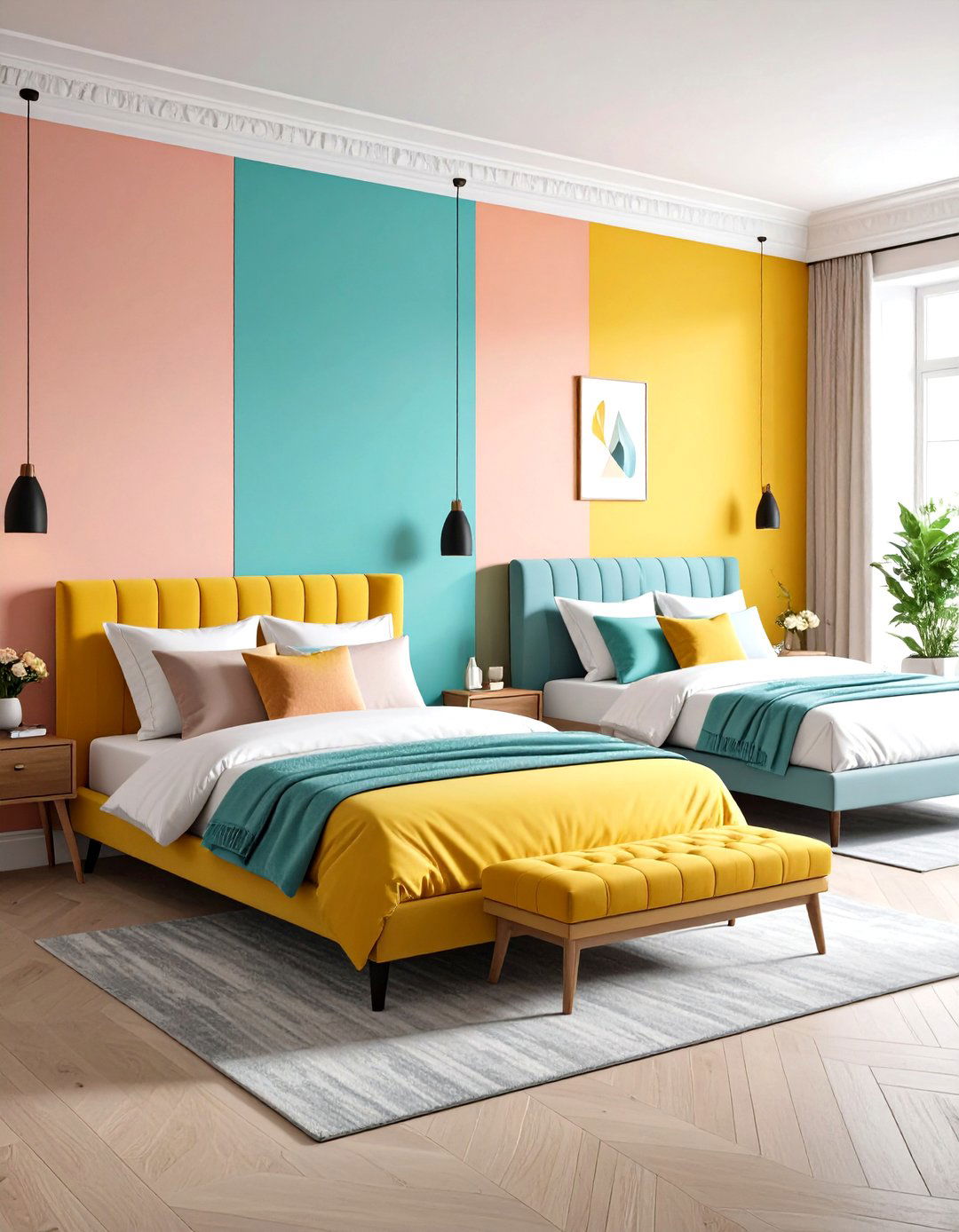
Painting color-blocked zones on walls is an affordable method to visually distinguish individual areas in a twin bedroom. By applying a two-tone or geometric paint scheme behind each bed, you introduce definition without physical dividers. In a Paris boutique room designed by Vanessa Scoffier, twin beds spaced a stool’s width apart were flanked by soft pastel hues that demarcated sleeping zones. To replicate this look, measure consistent sections, select complementary shades, and use painter’s tape for crisp separations. The result is a playful, artistic backdrop that personalizes each side while maintaining unity within the overall design.
18. Personalize With Wall Art
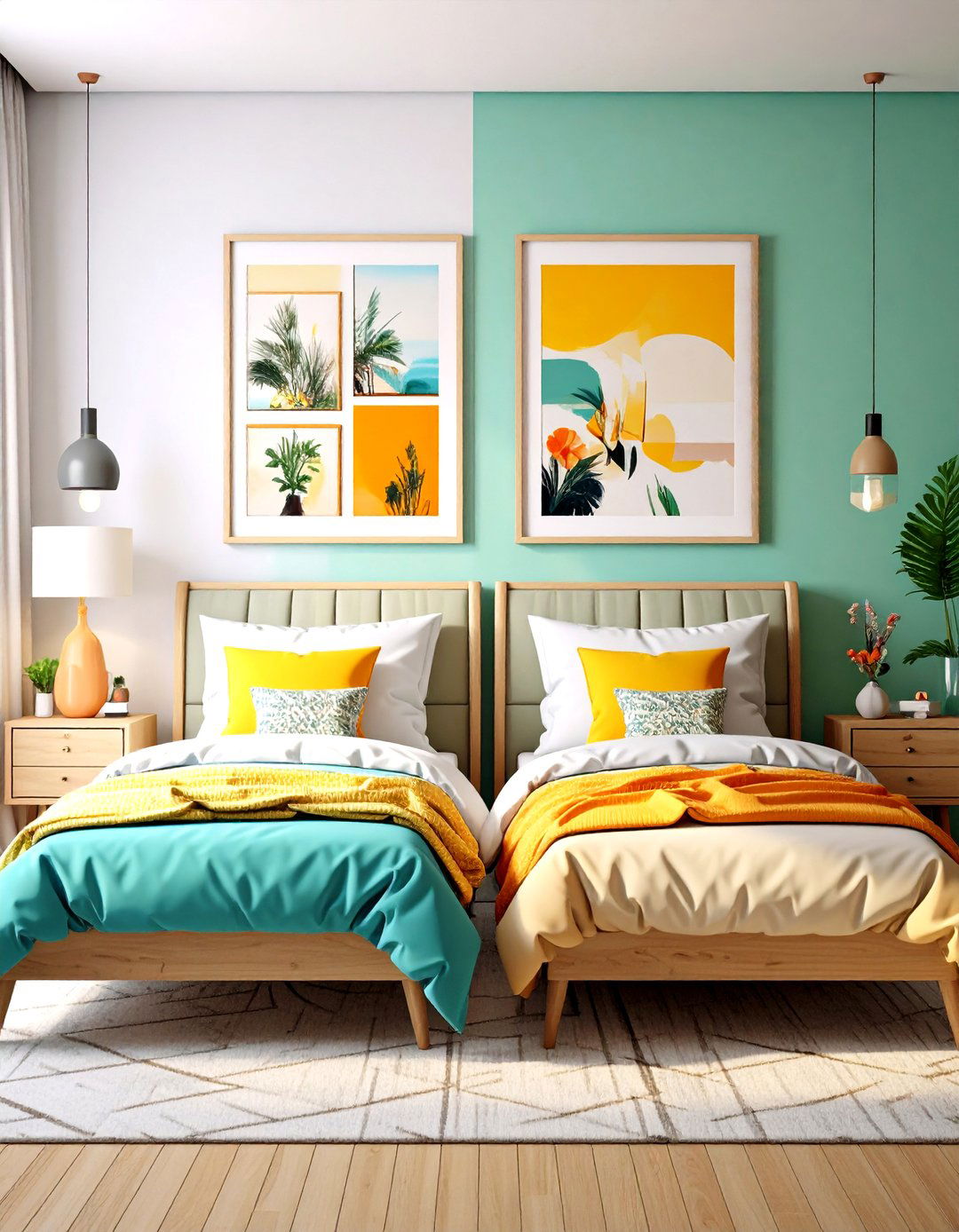
Personalizing each twin bed area with unique wall art adds character and avoids a monotonous look. Start by installing a shared or continuous headboard to tie the beds together visually, then hang individual pieces—such as framed photographs or prints—above each mattress. Christina Kim Interior Design employs this tactic by displaying distinct artworks over twin beds, ensuring each space feels customized yet connected by the common headboard. Select prints that reflect each occupant’s taste or choose complementary color palettes for cohesion. This approach balances uniformity with personal flair, transforming a standard twin setup into an expressive and inviting retreat.
19. Consider a Murphy Bed
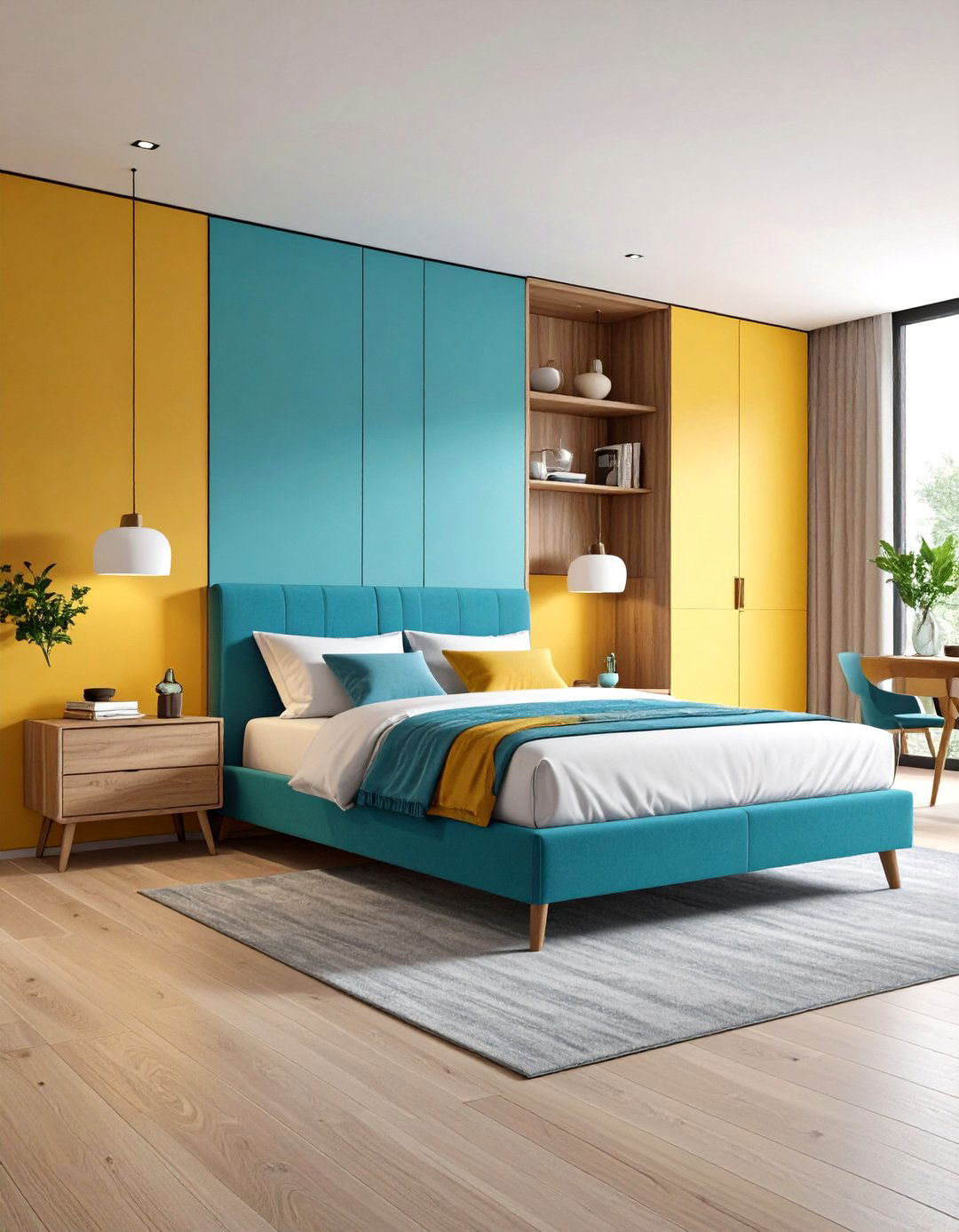
Integrating a twin-sized Murphy bed into a shared bedroom design maximizes floor space when the bed is not in use. Murphy beds fold up against the wall or into cabinetry, freeing the room for daytime activities or additional furniture. In a minimalist project by MKCA, a hidden wall bed discreetly resides above a dining nook, delivering sleeping functionality without sacrificing style. Look for models with integrated shelving or desk faces to further enhance utility. When installing a twin Murphy bed, ensure sturdy hardware and consider customizing the exterior finish to match your décor for a seamless, built-in appearance.
20. Add Extra Seating
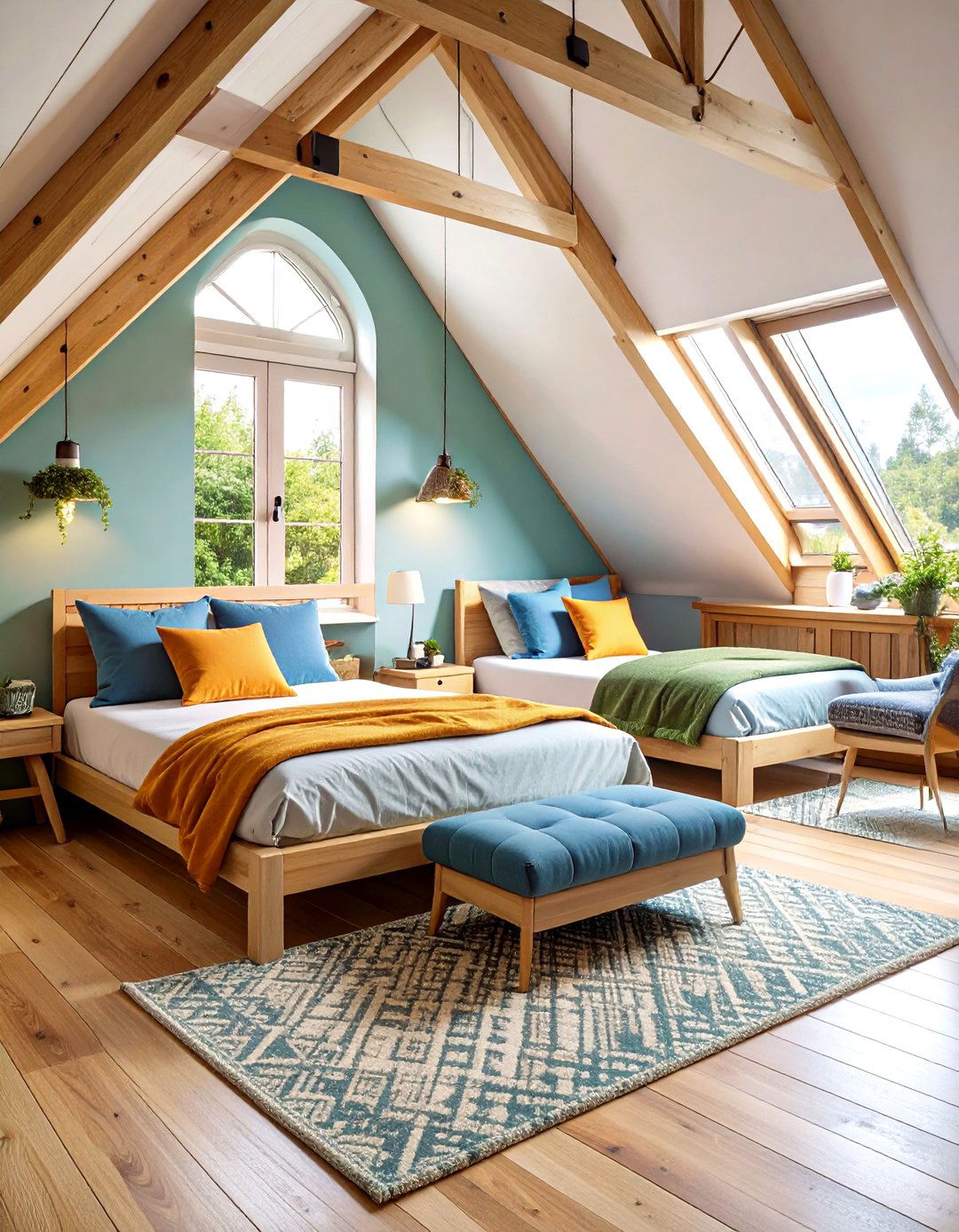
Adding seating elements—like an armchair, pouf, or bean bag—at the foot of each twin bed introduces dedicated lounging nooks separate from the sleeping area. These low-profile pieces provide comfortable spots to read, put on shoes, or relax with a cup of coffee without infringing on the beds themselves. In a compact attic design highlighted by Mary Patton Design, small poufs at the end of each bed added texture and function while maintaining clear pathways. Opt for lightweight, portable chairs or cushions that can be easily moved to accommodate cleaning or bedroom reconfiguration, ensuring both style and flexibility.
Conclusion:
From ingenious storage hacks to thoughtful lighting installations, these 20 twin bedroom ideas demonstrate the versatility and creative potential inherent in shared sleeping spaces. By leveraging strategies like hidden compartments, wall-mounted fixtures, or decorative half walls, you can optimize floor plans while maintaining an inviting aesthetic. Accent treatments—horizontal stripes, canopies, personalized artwork—add visual intrigue, while seating and daybed conversions broaden functionality. Whether you’re designing for children, guests, or multifunctional rooms, these concepts blend style and practicality to transform twin bedrooms into cozy havens. Experiment with these techniques to craft a tailored layout that celebrates symmetry, maximizes every inch, and reflects individual personalities.


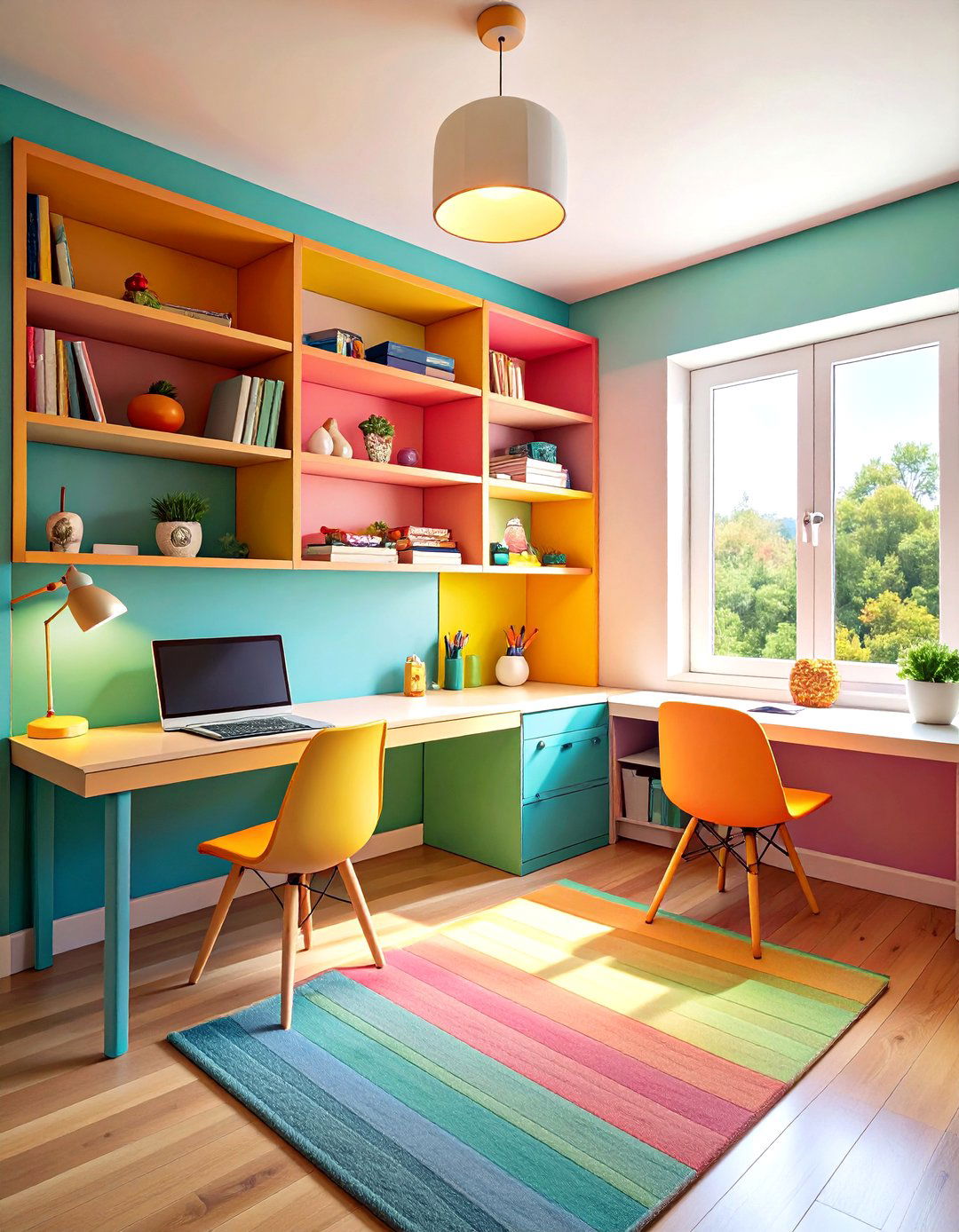
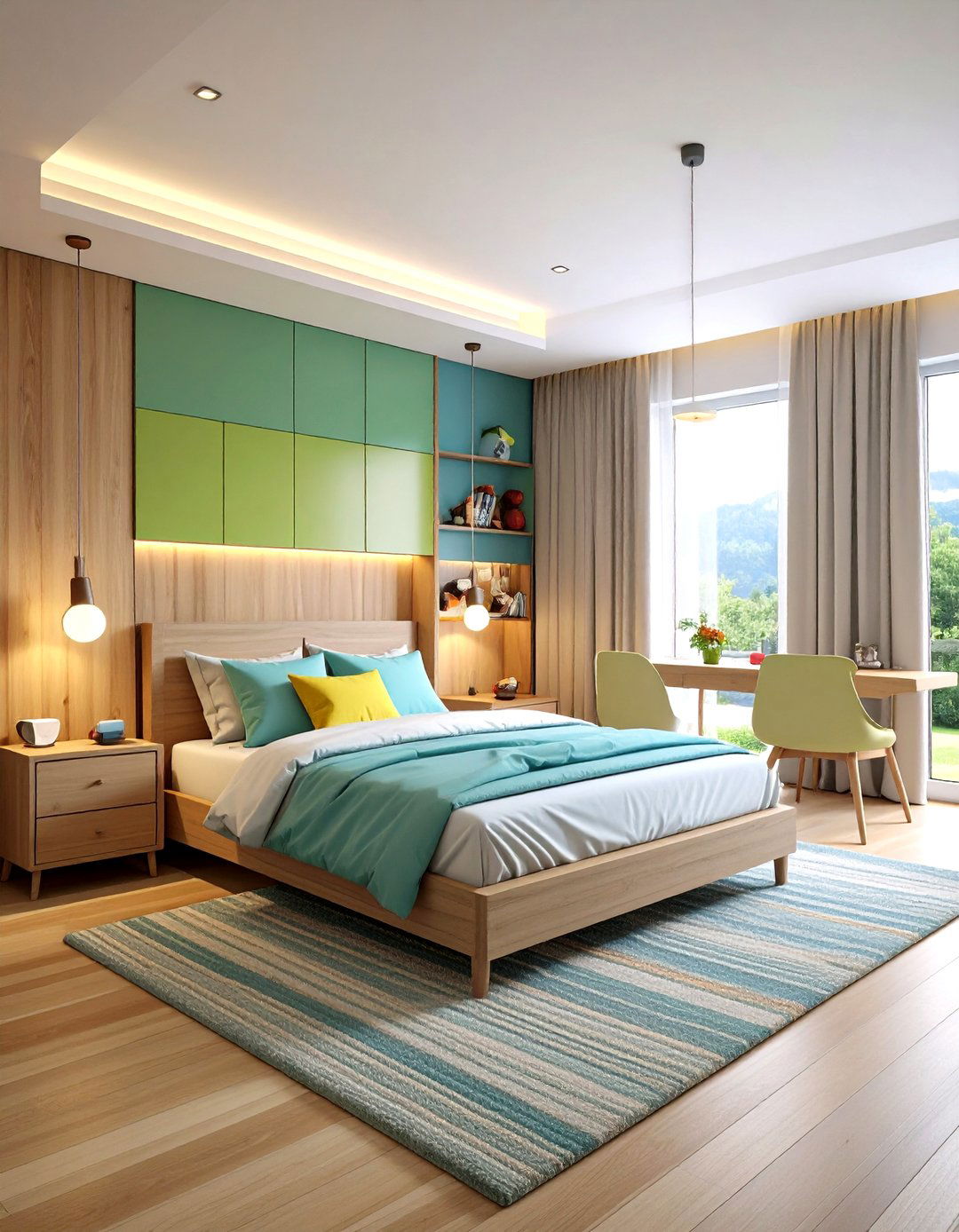
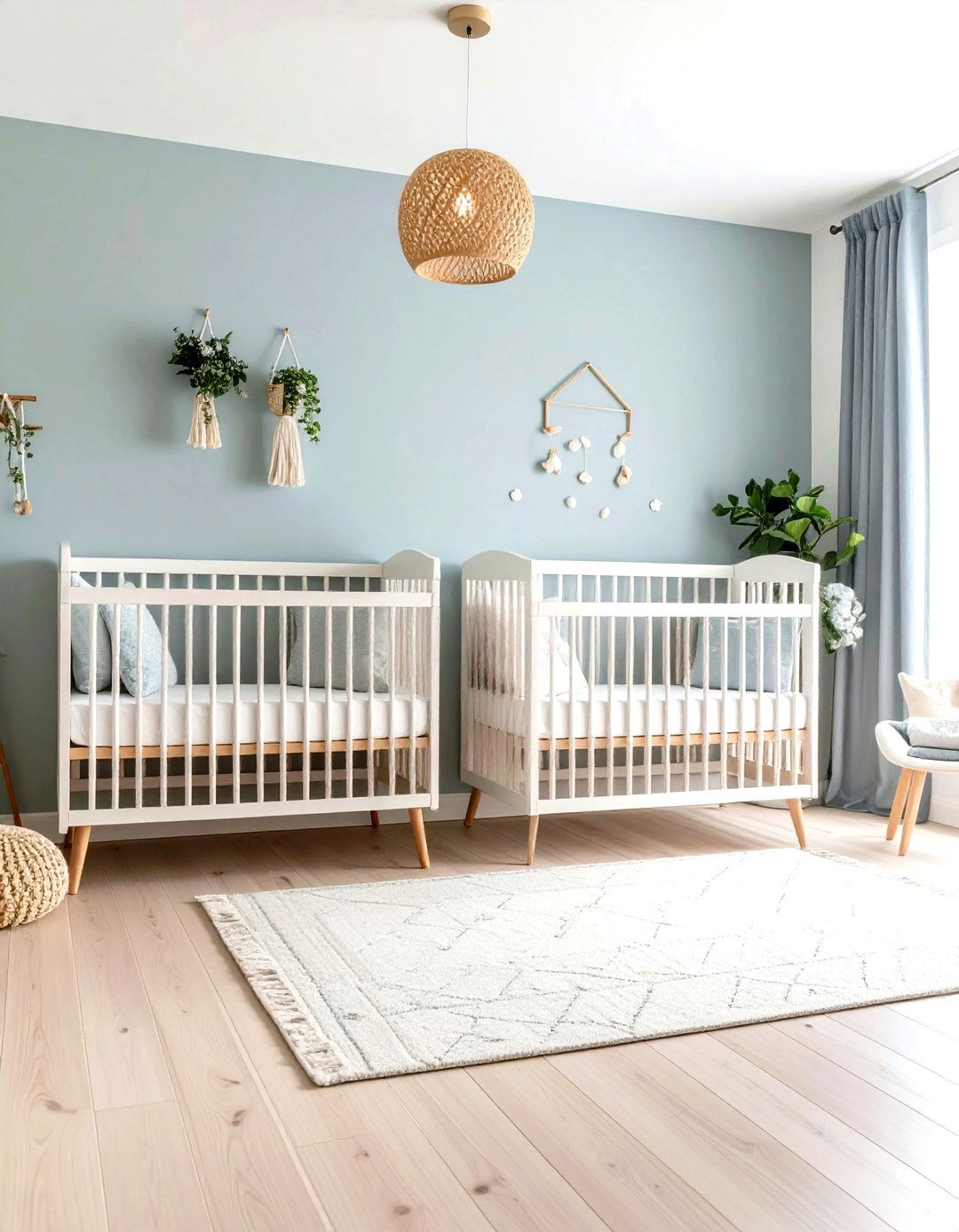
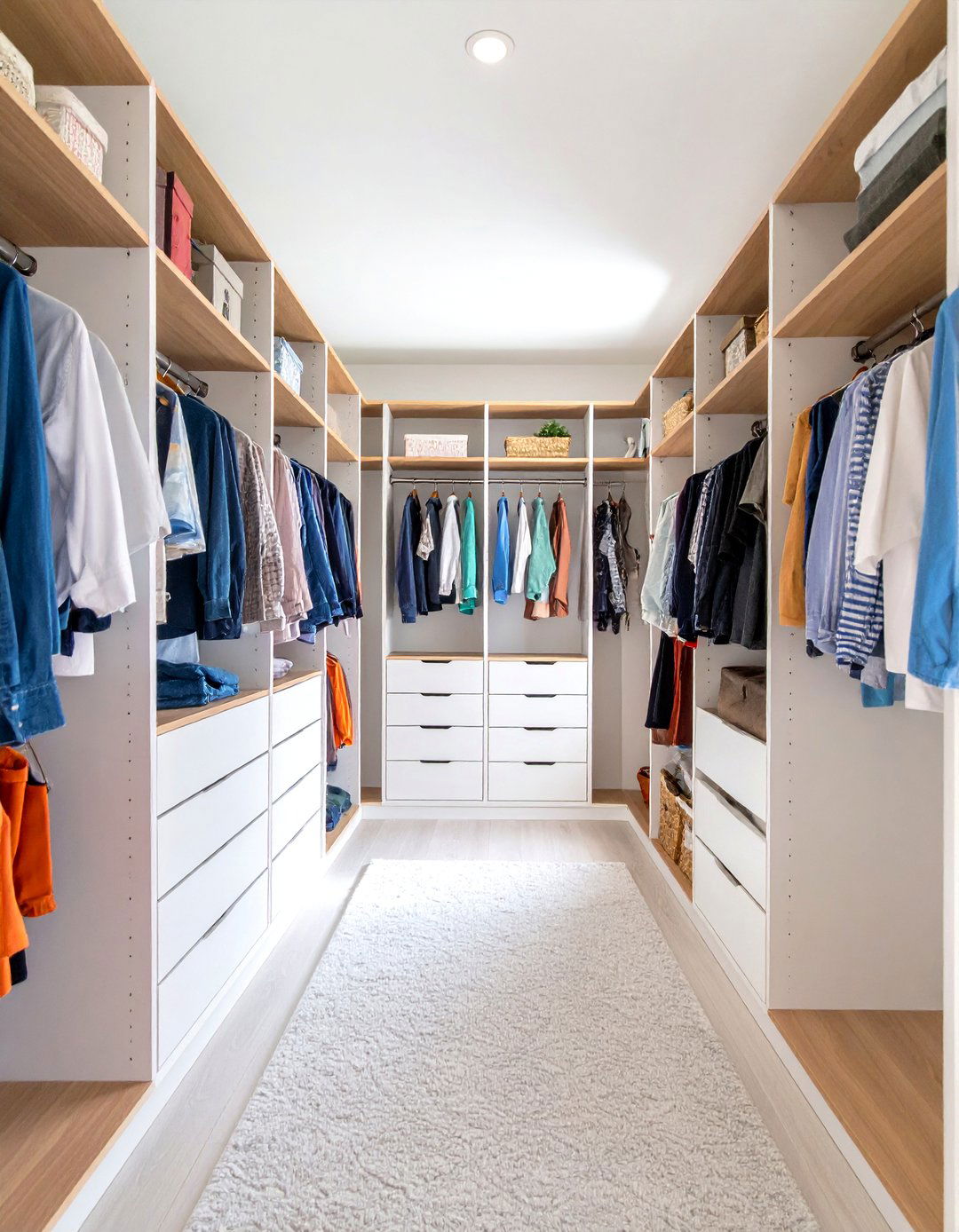
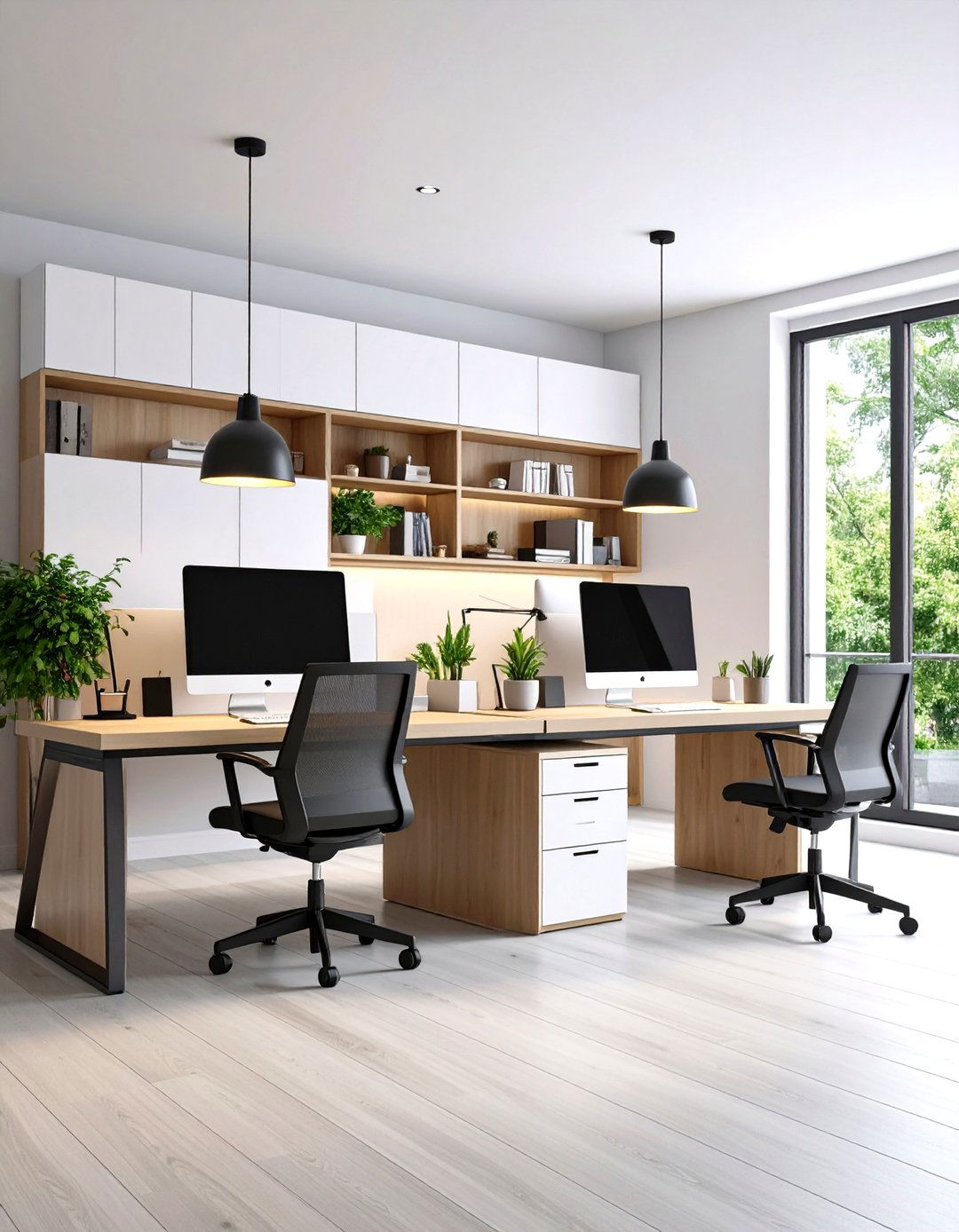
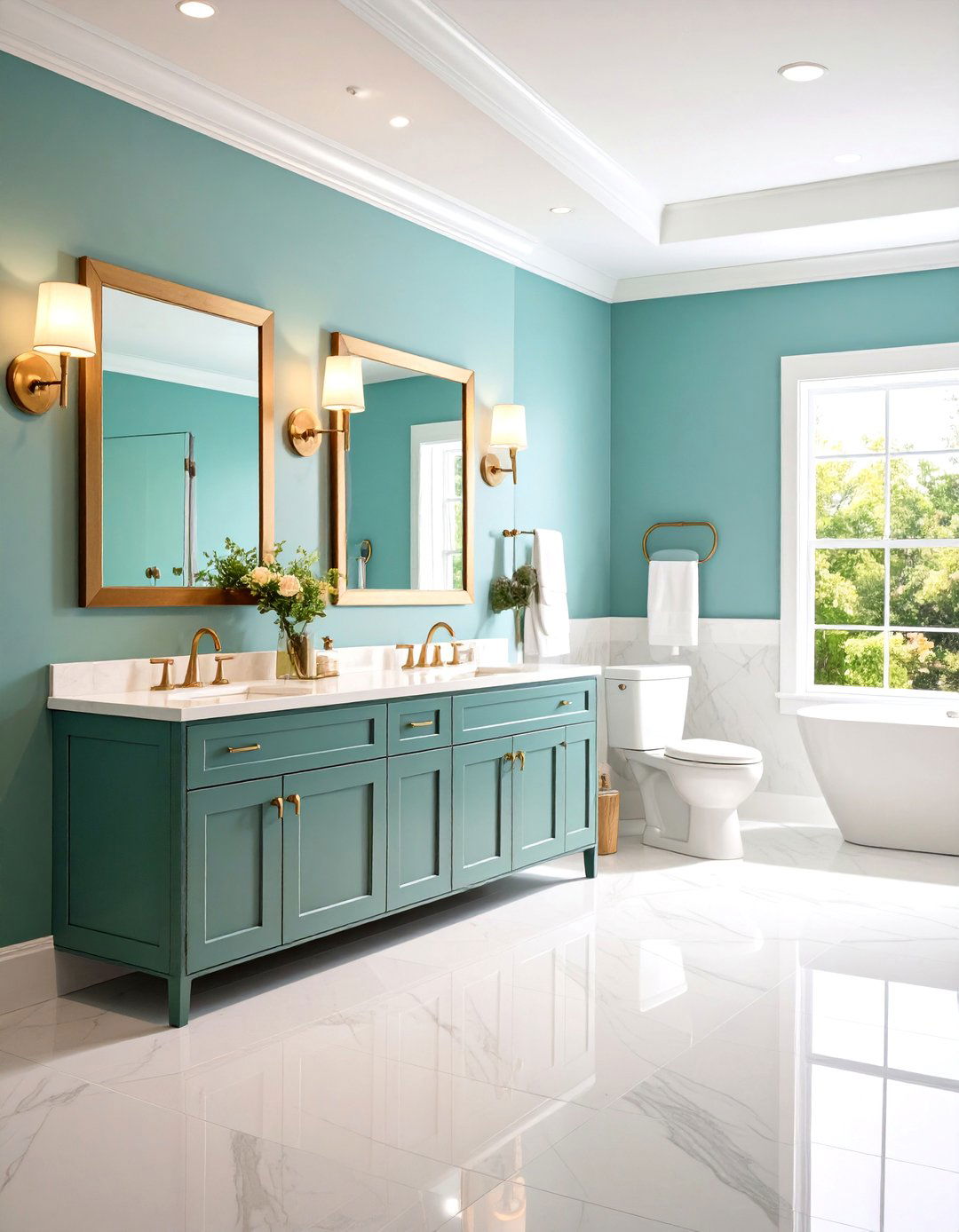
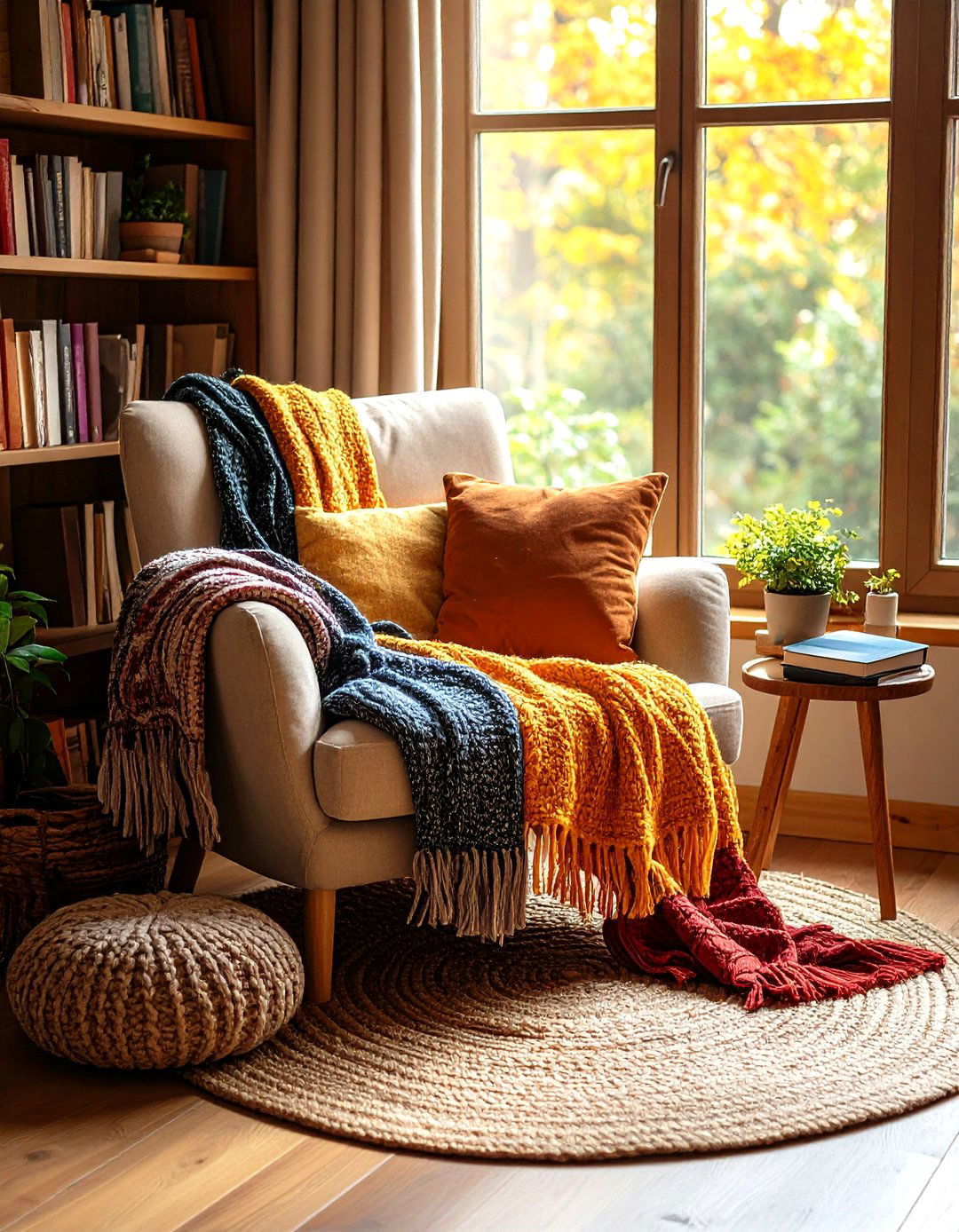
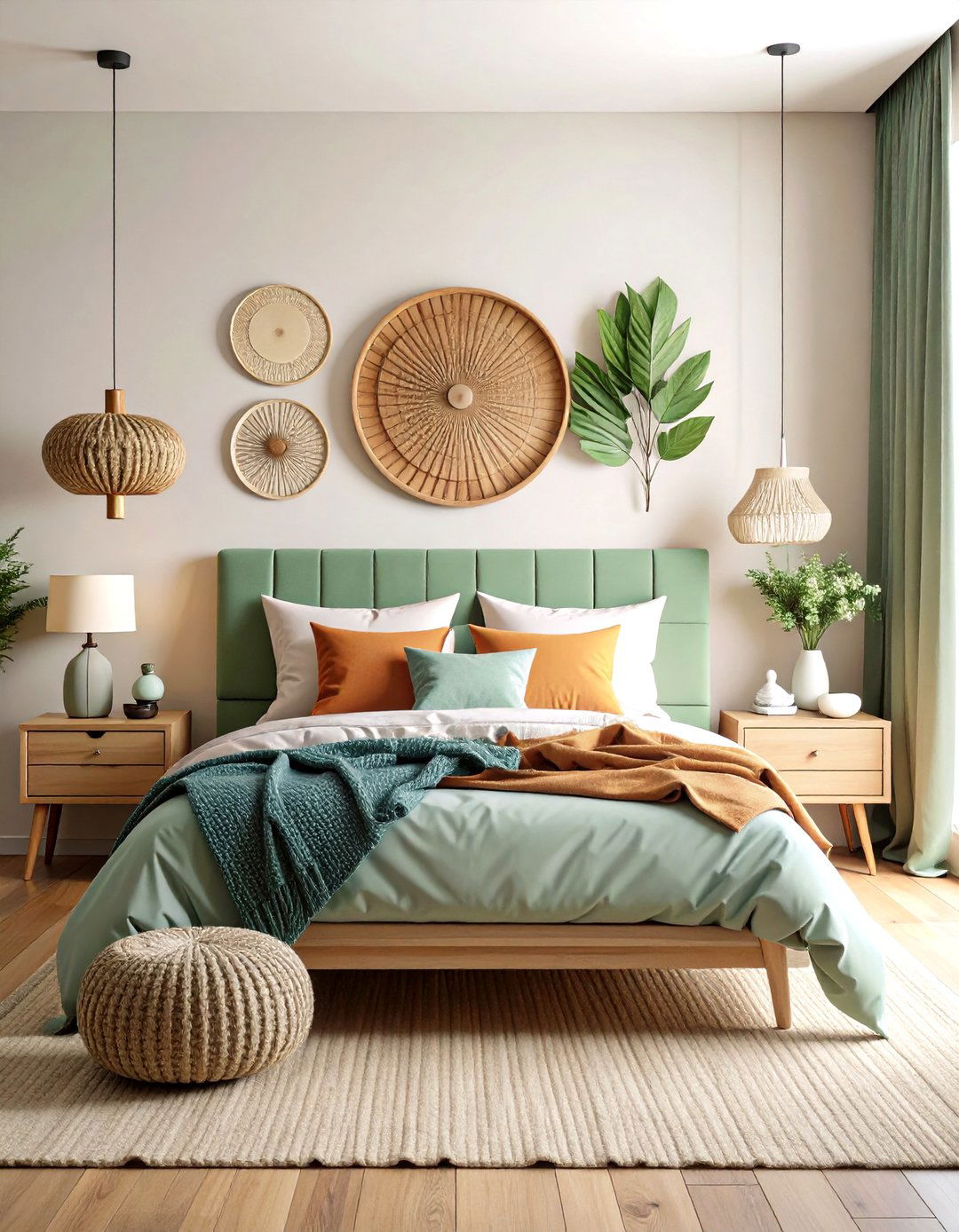
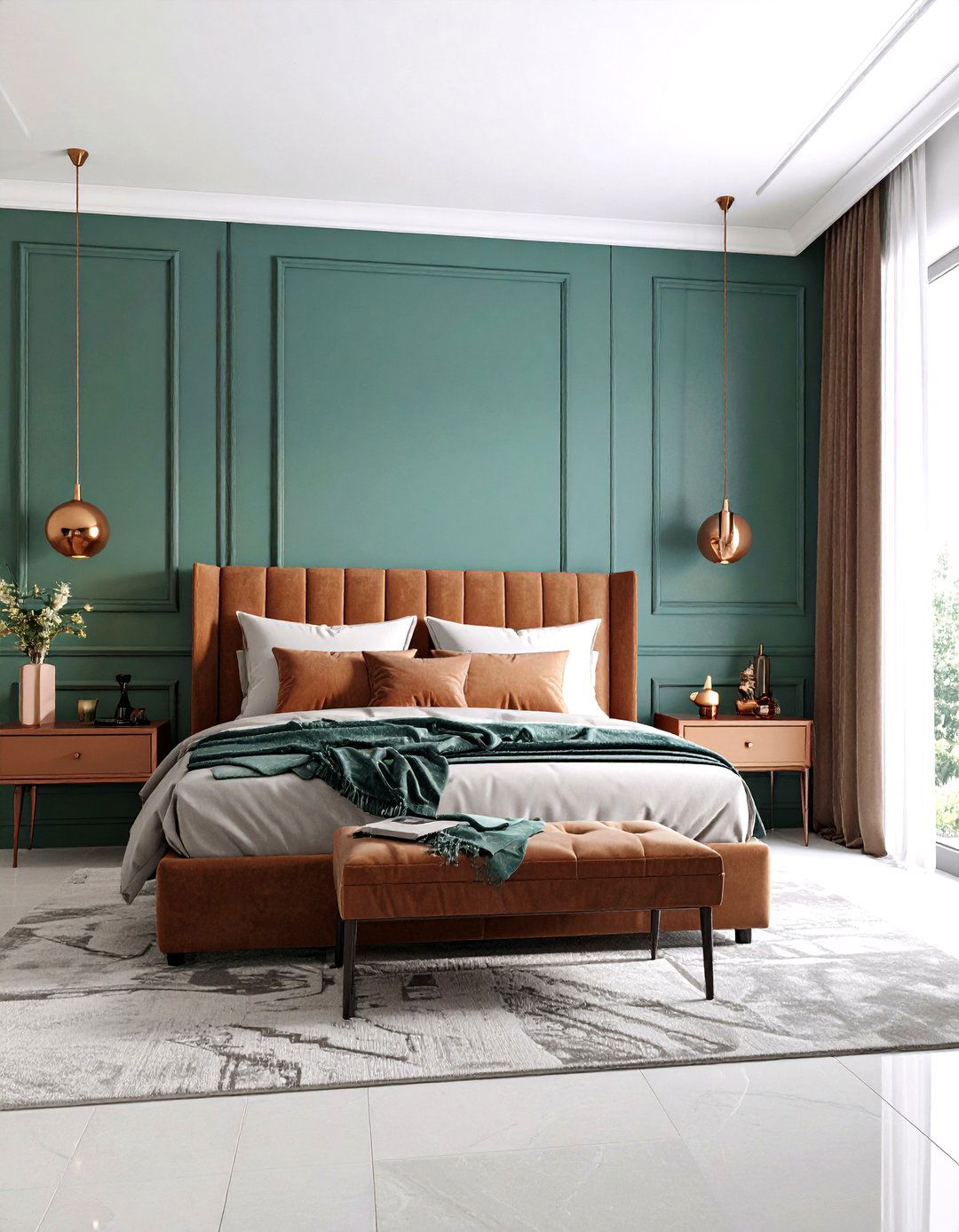
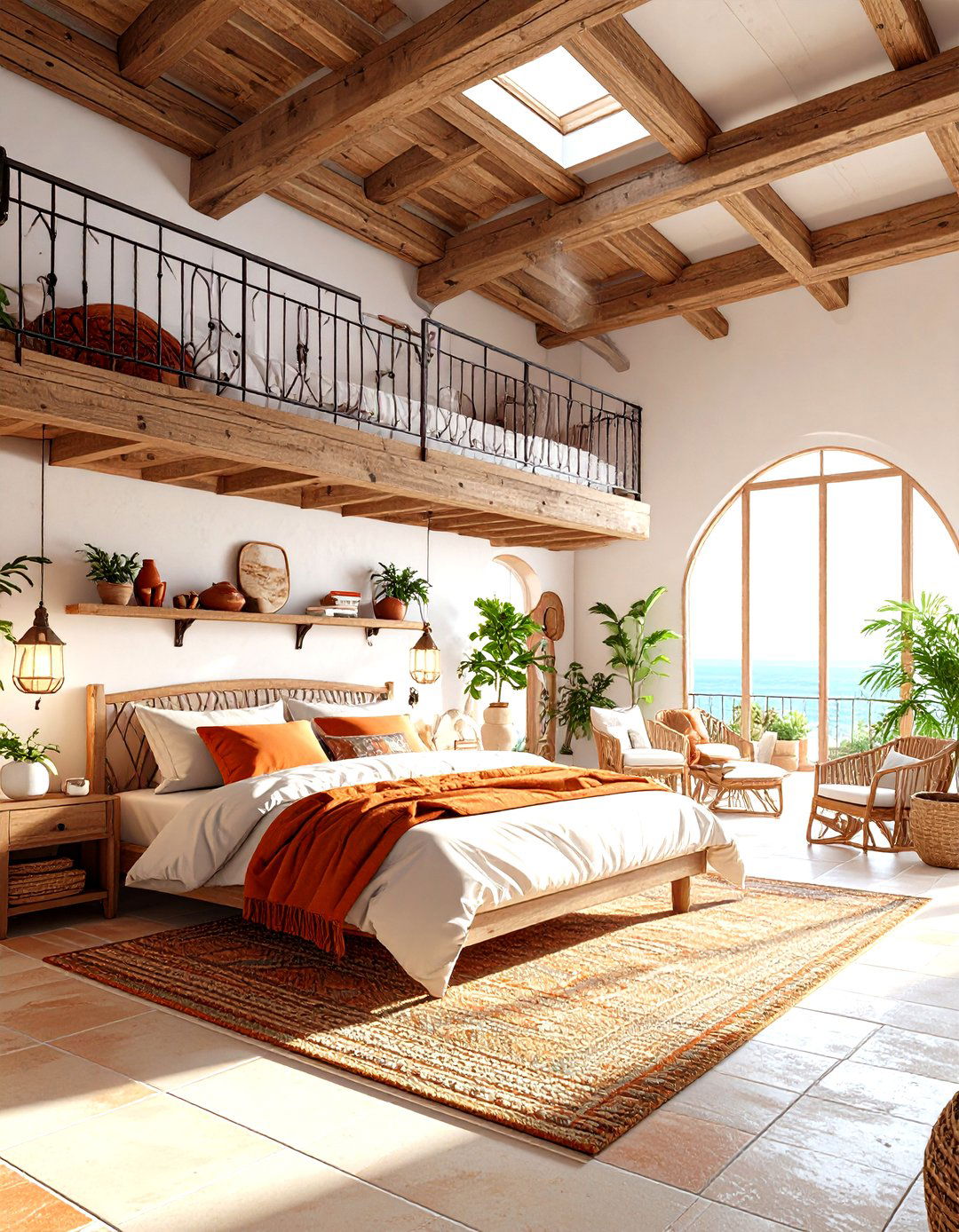
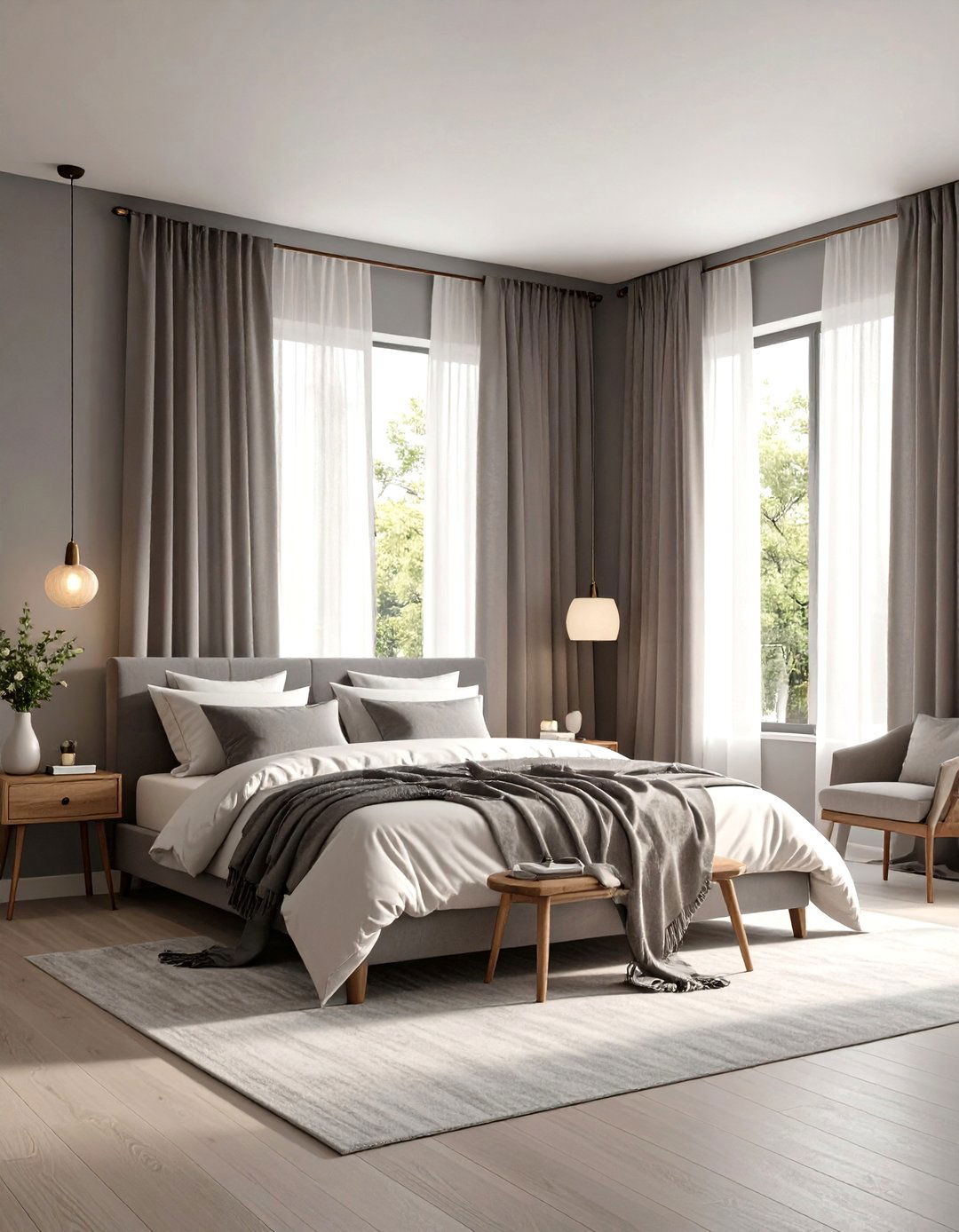
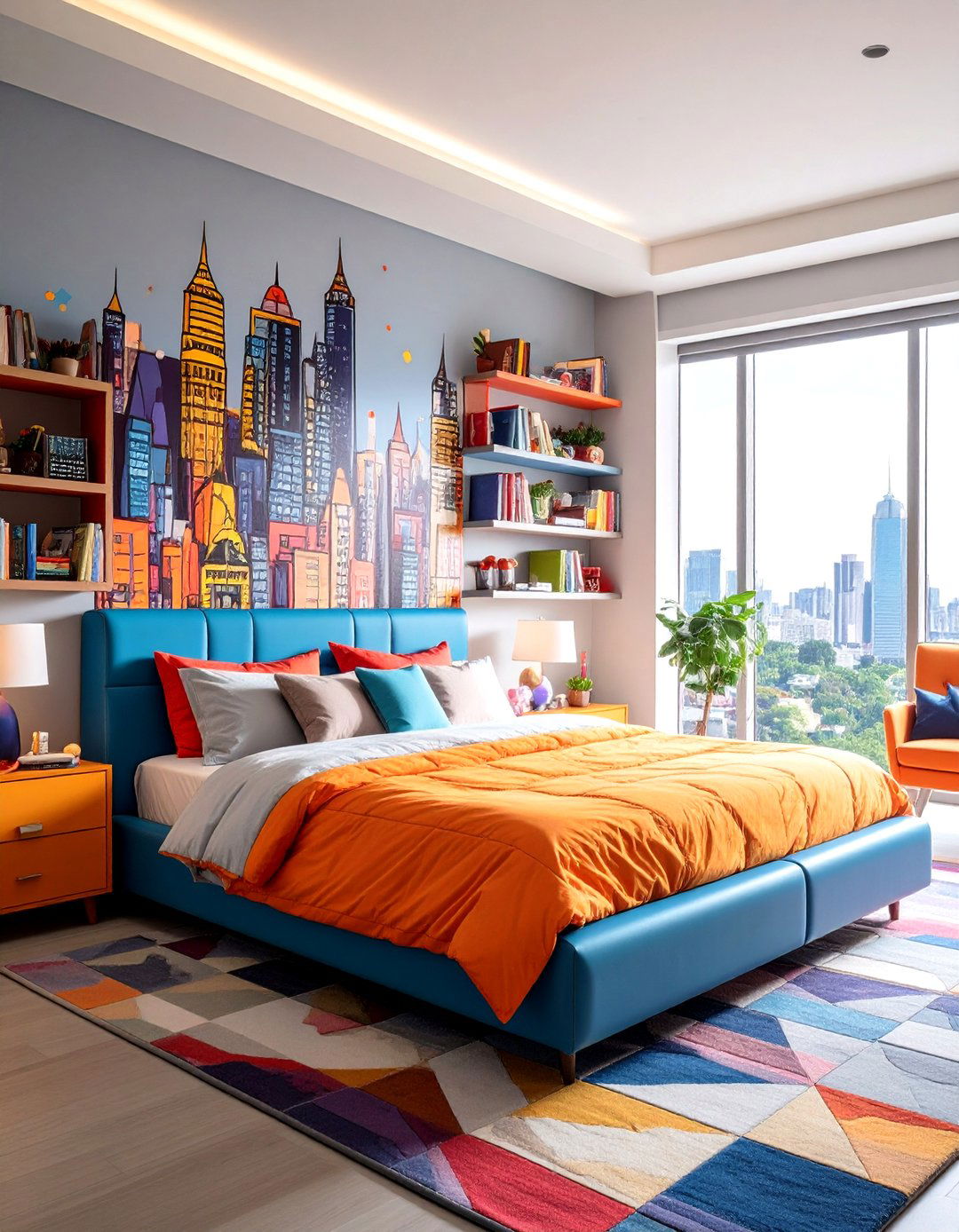
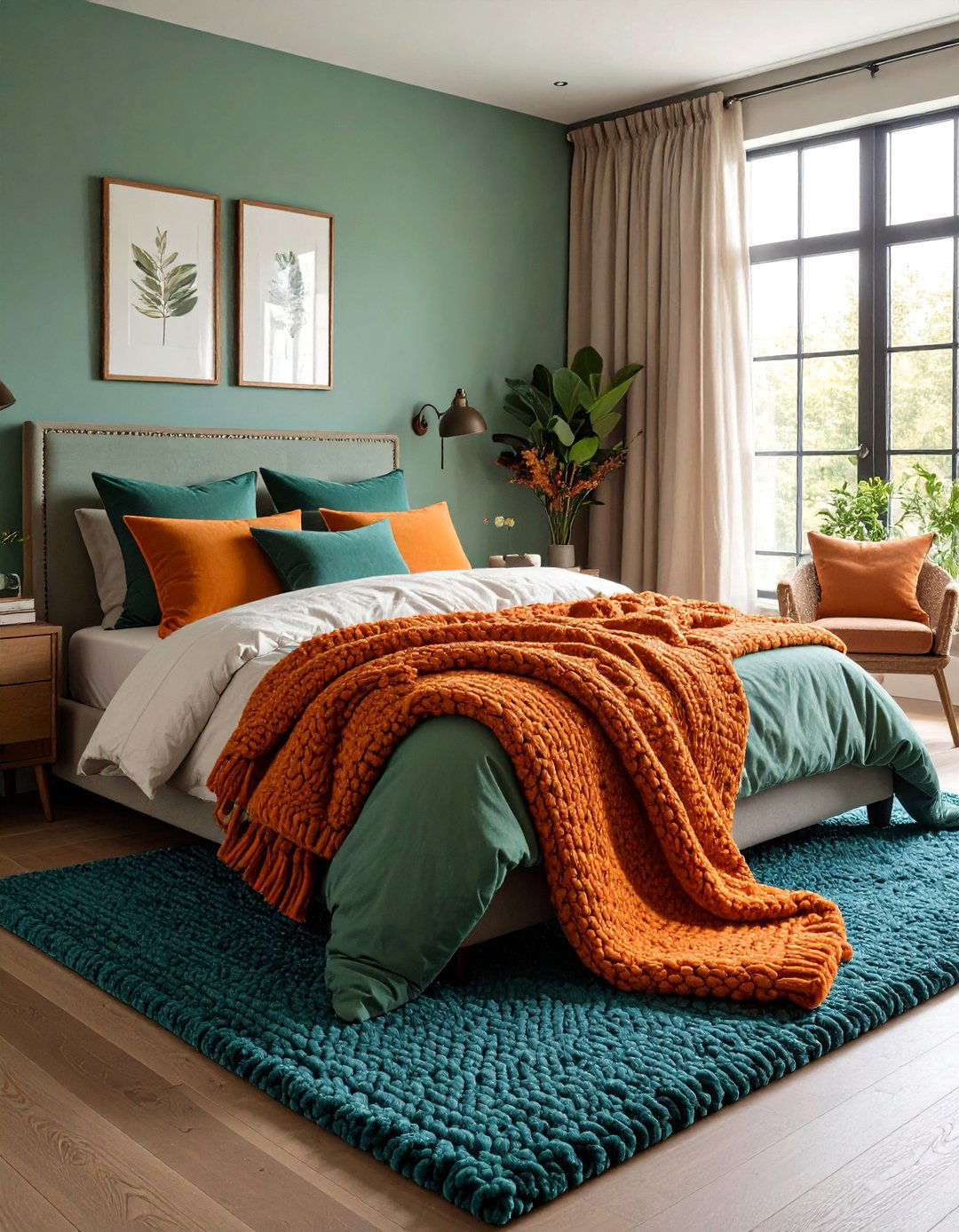
Leave a Reply